North America is home to a wide range of black and yellow beetles. These beetles come in contrasting coloring which might make them look poisonous.
Most black and yellow beetles are harmless. They feed on plants as adults.
Some of the black and yellow beetles found in the US exclusively feed on a single category of plants or vegetables such as cucumbers, squash, or shrubs such as Anacahuita.
Beetles that bear black and yellow coloring are rarely pests, but they can make it indoors on occasion. They can be eliminated by different means, depending on their species.
Table of Contents
Are black and yellow beetles dangerous?
Black and yellow beetles don’t generally sting. Some of these beetles have elongated mouthparts but they don’t use them against humans.
Black and yellow color combinations can lead people to believe these beetles are toxic as this color combination is toxic in other species.
Spotted salamanders are black and yellow and have toxins that may cause skin irritation in humans. Most black and yellow beetles are harmless.
Types of Black and Yellow Beetles
Here are the most common beetles with black and yellow coloring found in North America and around the world.
1. Spotted Cucumber Beetle
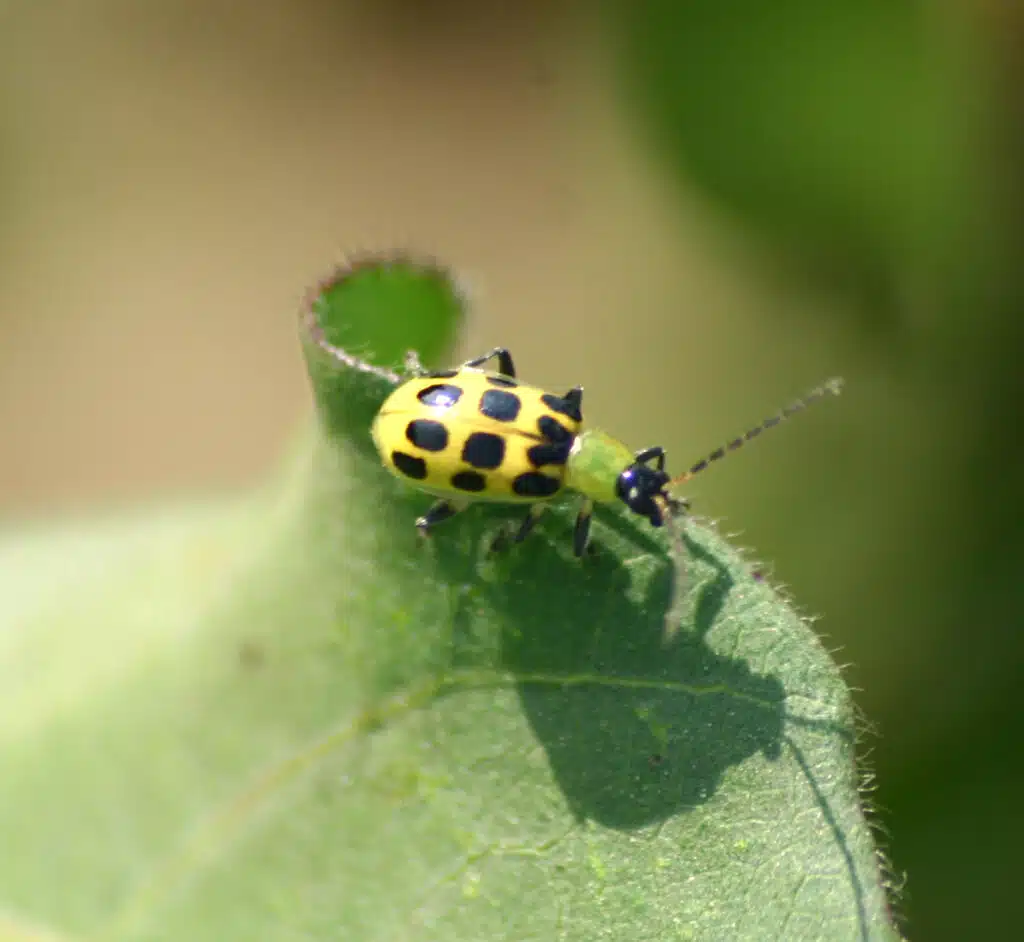
Spotted Cucumber beetles (Diabrotica undecimpunctata) are one of the most common black and yellow beetles across North America.
These bugs are highly common on cucumbers and cucumber leaves. They rely on cucumber leaves for food.
Spotted cumbers have exactly 12 black spots on the elytra. The background color is yellow or yellow-green to be in tune with the color of cucumber leaves.
These bugs are invaders or pests of cucumbers. They feed on entire cucumber leaves essentially killing the plant.
Spotted Cucumber beetles are a resilient species. They may overwinter in the ground in the same spot to emerge the following year.
2. Locust Borer
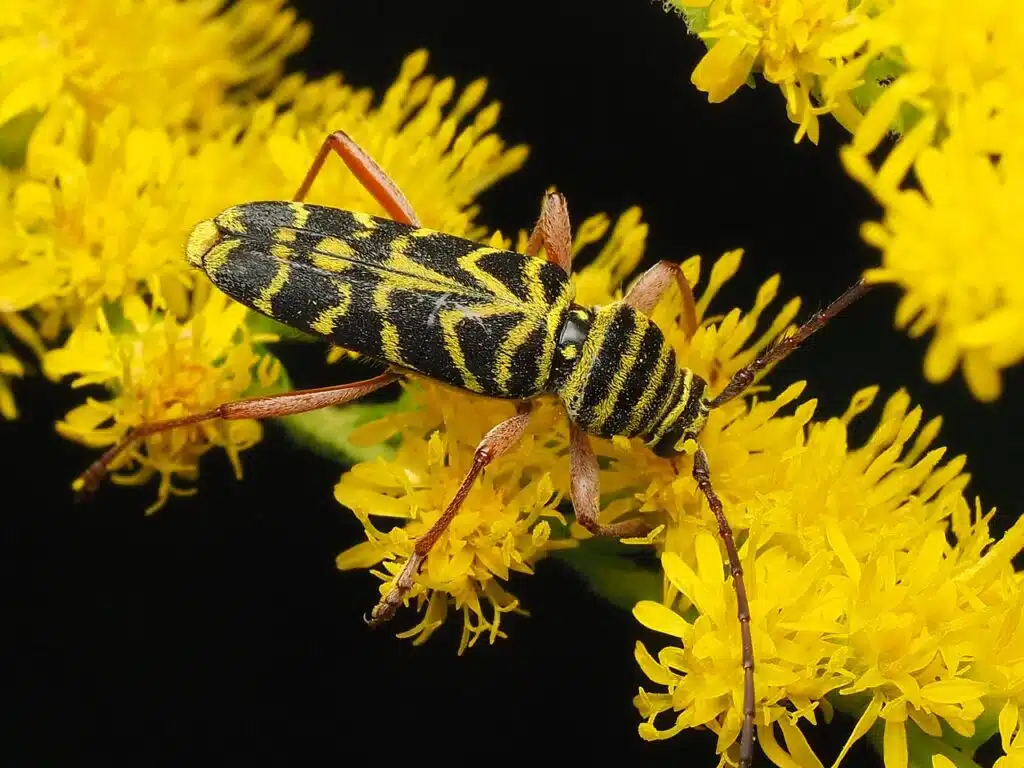
Locust Borers (Megacyllene robiniae) are another species of black and yellow beetles. These bugs take the color of some of their favorite plants such as goldenrods.
Locust Borers have a black and yellow body.
The elytra are mostly black with W-shaped yellow marks across.
Bugs of this genus are often taken for bees due to their black and yellow coloring.
They have a large body that grows to 28mm and very long antennae which can be up to a third of the length of these bugs’ bodies.
You can differentiate male Locust Borers from female Locust Borers by the length of their antennae.
Males have longer antennae while females have antennae that are 1.5 times the size of their bodies.
3. Eastern Hercules Beetle
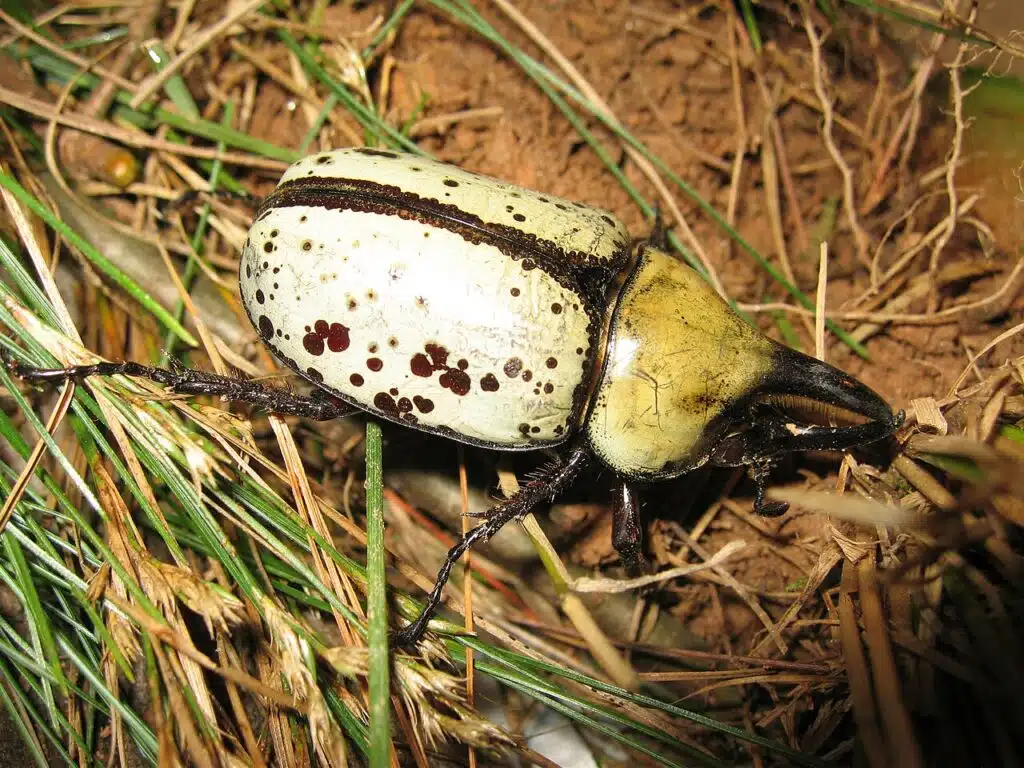
The Eastern Hercules Beetles (Dynastes tityus) are some of the largest black and yellow beetles in the US. These bugs grow to a size of up to 7 inches.
Even their feces are large as they can measure up to 4 inches.
These beetles come in green and black or yellow and black colors. The color of the elytra is yellow also displaying black spots.
Rotting goods are the main food of this species. From rotting fruit to rotting wood, Eastern Hercules Beetles can eat almost anything they can find.
These beetles might be seen in the summer when females are most active laying eggs in the ground.
4. Ornate Checkered Beetle
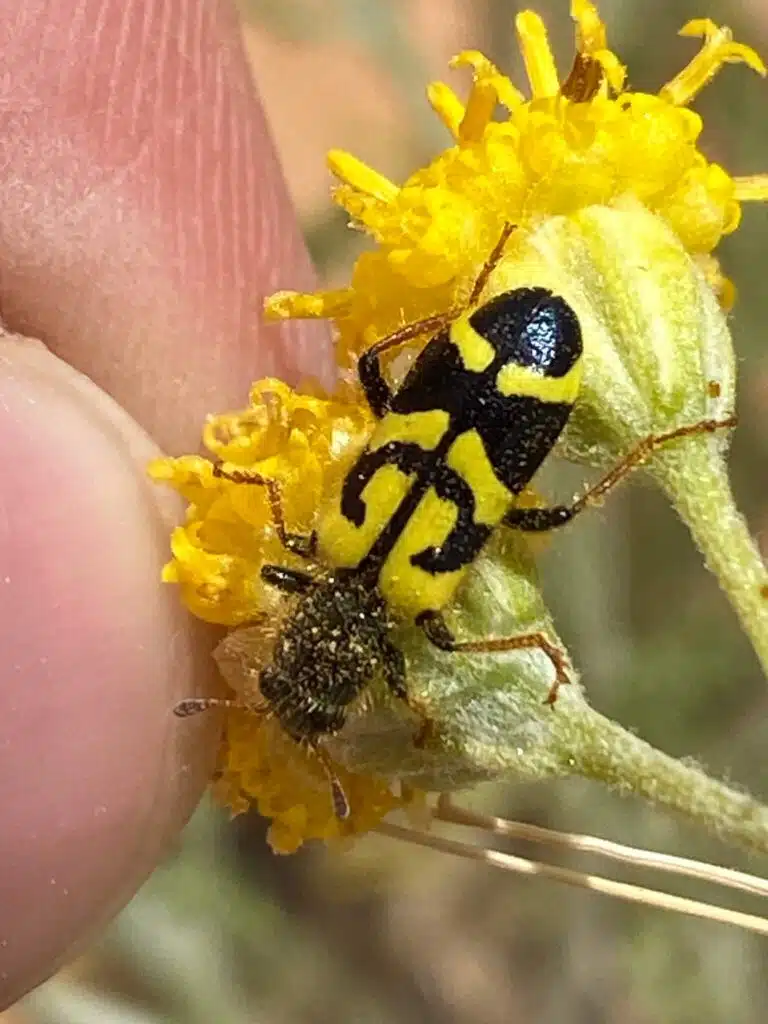
Ornate Checkered Beetles (Trichodes ornatus) have black and yellow coloring. Yellow stripes are seen on the black elytra.
Short yellow hairs are also visible on its black legs.
This species often resembles the flowers it visits for pollen. Ornate Checkered Beetles feed on the pollen of yarrow as well as any other plant with a yellow flower bud.
Male Ornate Checkered Beetles are smaller than females as they grow up to 11mm. Females grow up to 15mm.
Ornate Checkered Beetle larvae are parasitic and feed on bees. Eggs are laid next to bees as parasite hosts.
5. Fourteen-spotted Lady Beetle
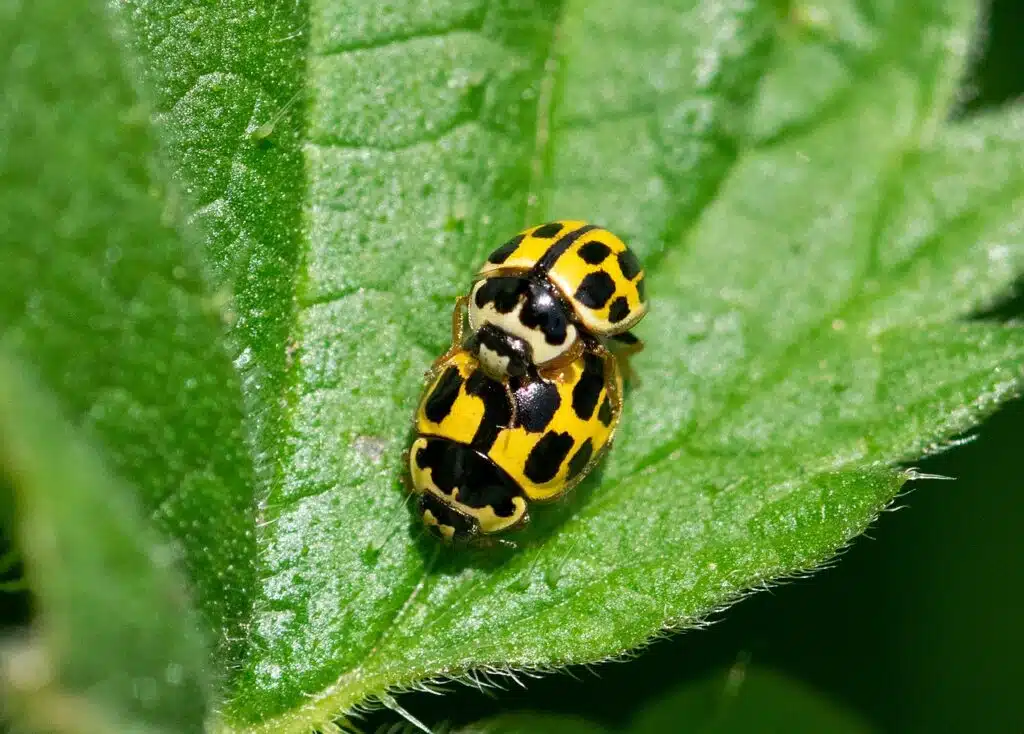
The Fourteen-spotted Lady Beetle (Propylea quatuordecimpunctata) has black and yellow coloring.
Known for its ladybeetle dome-shaped body, this species has alternating black and yellow spots on the elytra and the head.
This might be one of the friendliest-looking black and yellow bugs but it’s still a predatory species.
Fourteen-spotted Lady Beetles are predators of aphids.
These beetles are some of the most efficient predators of aphids to the extent they can eliminate aphid populations on wide areas such as crops, gardens, and greenhouses.
They are used commercially against wheat aphids. These small green aphids are consumed by both adult male and female Fourteen-spotted Lady Beetles.
6. Delta Flower Scarab
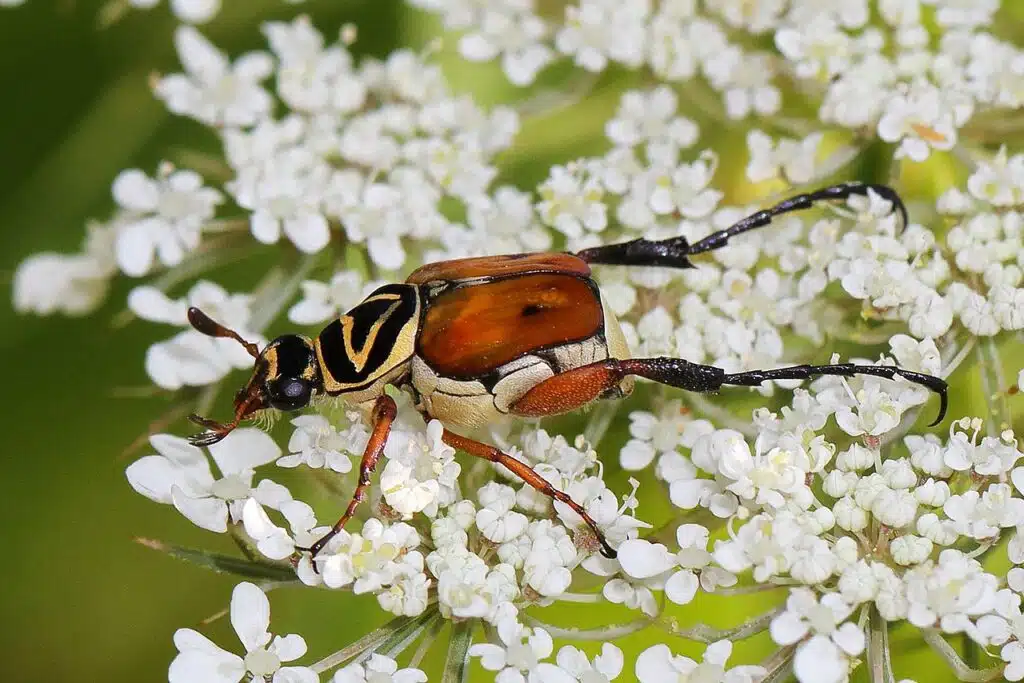
The Delta Flower Scarab (Trigonopeltastes delta) is one of the species of black and yellow beetles which mimics wasps.
It has a Delta-shaped yellow mark which makes it appear like a wasp to avoid predators.
If its pronotum is black and yellow, its elytra are mostly brown or orange-brown with a rectangular shape.
The Delta Flower Scarab is one of the few bugs with rectangular elytra.
Feeding on nectar, the Delta Flower Scarab is native to the US. The species mostly live in Eastern US territories.
7. Striped Cucumber Beetle
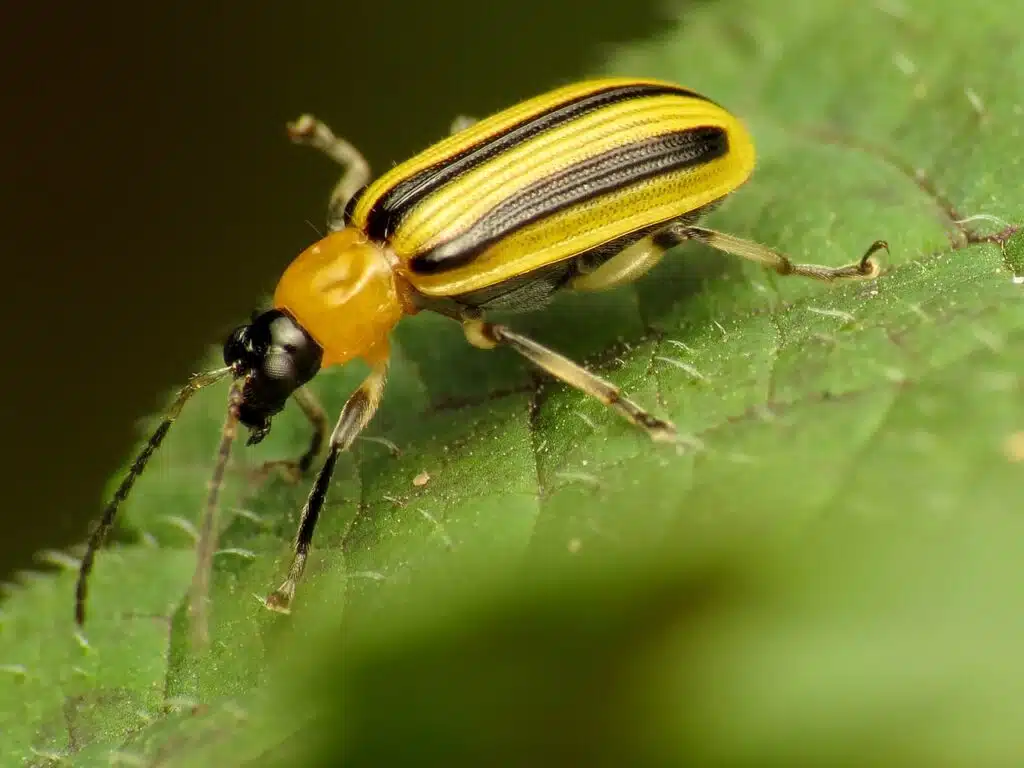
Striped Cucumber Beetles (Acalymma vittatum) have a black and yellow body. These bugs have alternating black and yellow stripes.
The head is also black and yellow.
Striped Cucumber Beetles pose a real threat to cucumber crops as they consume the foliage of cucumbers.
Some of the first signs that indicate the presence of thee beetles are leaves of cucumbers that start to lose their vigor and shape.
These bugs are attracted to the smell of cucumbers and they always make their way to new cucumber crops.
Only pesticides are a proven solution against Striped Cucumber beetles.
8. Colorado Potato Beetle
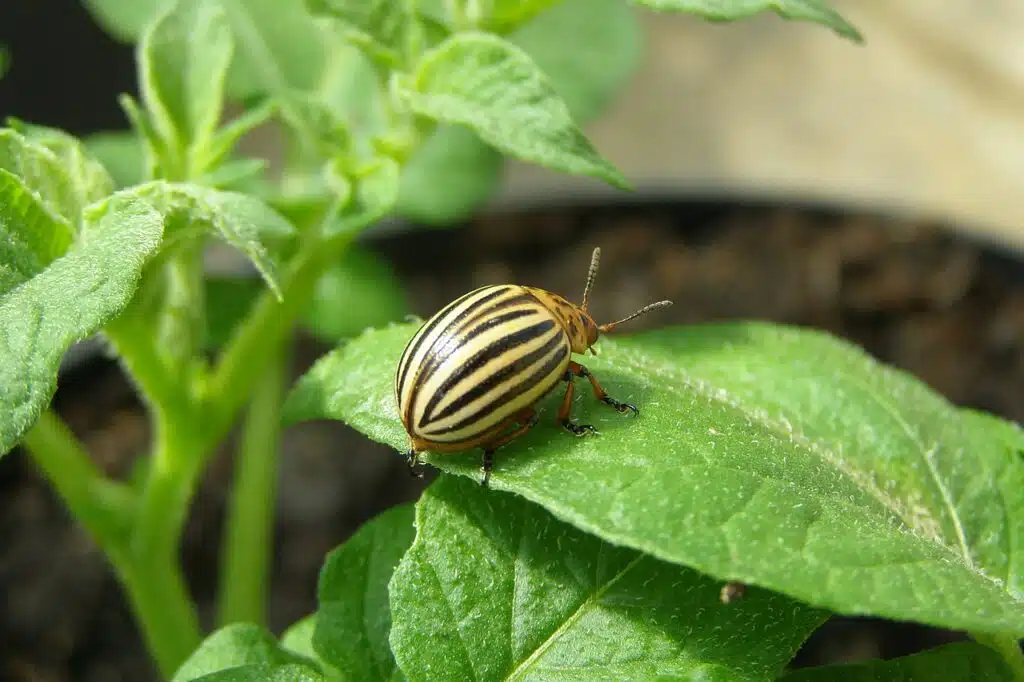
Colorado Potato beetles (Leptinotarsa decemlineata) are some of the most common invasive black and yellow beetles.
A pale yellow color is combined with black in a striped form to build the elytra of this common species.
Growing to a size of up to 11mm, this species is native to the US.
Most notably seen on buffalo-bur, this species is considered the most common pest of potatoes in many parts of the world.
Rapid multiplication rates mean the Colorado Potato Beetle might only be fully controlled with pesticides.
These beetles don’t bite and can be hand-picked on small potato plantations.
9. Three-lined Potato Beetle
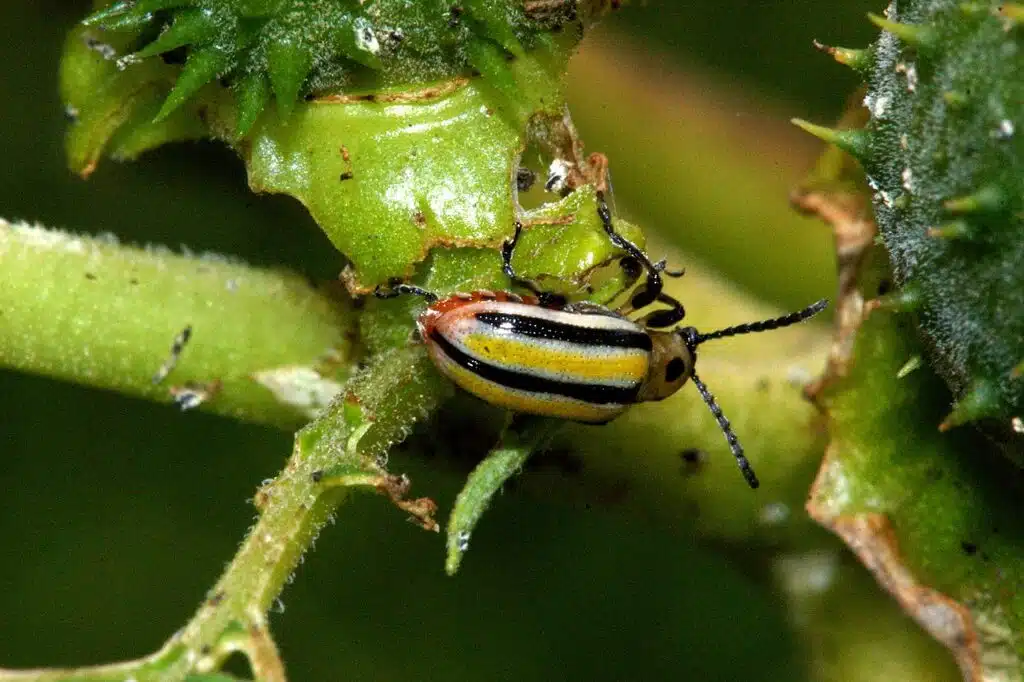
Three-lined Potato beetles (Lema daturaphila) have yellow, black, and white stripes. Its antennae are black.
Tomatillo is the main affected plant when it comes to the Three-lined Potato Beetle.
However, this beetle also eats tomatoes and potatoes, just like the Colorado Potato Beetle.
Growing to a size of up to 8mm, Three-lined Potato Beetles are difficult to control by hand.
Like most types of invasive species, Three-lined Potato Beetles are controlled with pesticides.
10. Mottled Tortoise Beetle
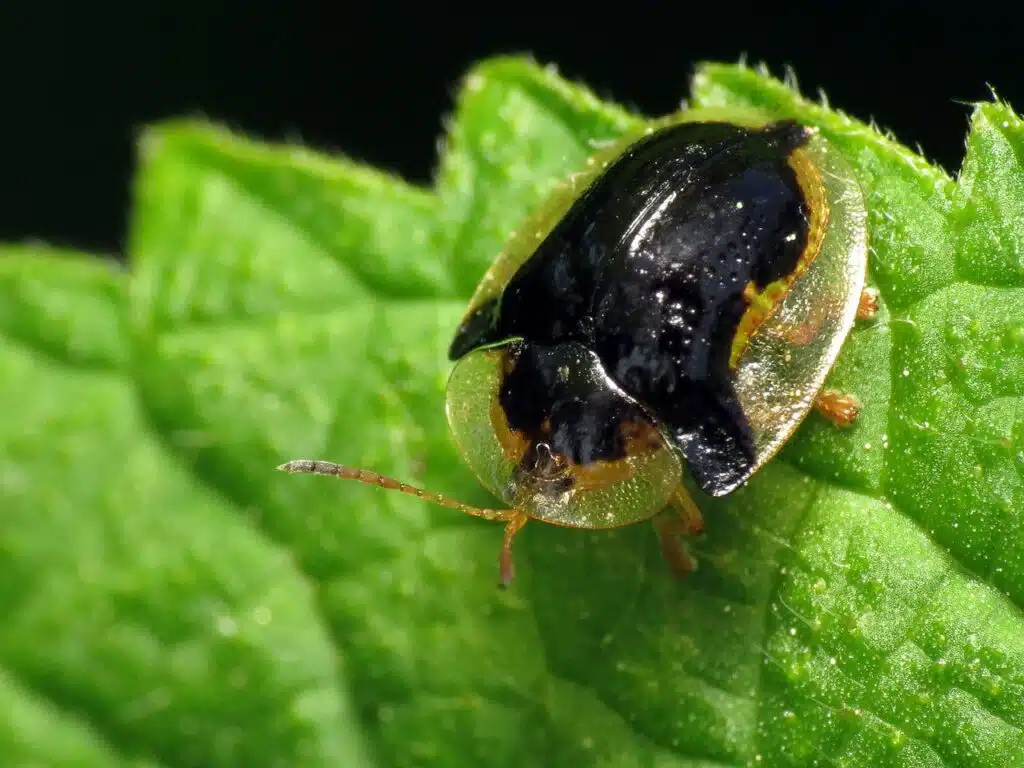
The Mottled Tortoise Beetle (Deloyala guttata) is one of the species of black and yellow beetles that change coloring.
This species adapts its yellow coloring to golden-yellow coloring as it grows.
The Mottled Tortoise Beetles are common across North America in multiple species and sub-species.
Mottled Tortoise Beetles are seen in large numbers across most states but the species isn’t considered a pest.
11. Elm Leaf Beetle
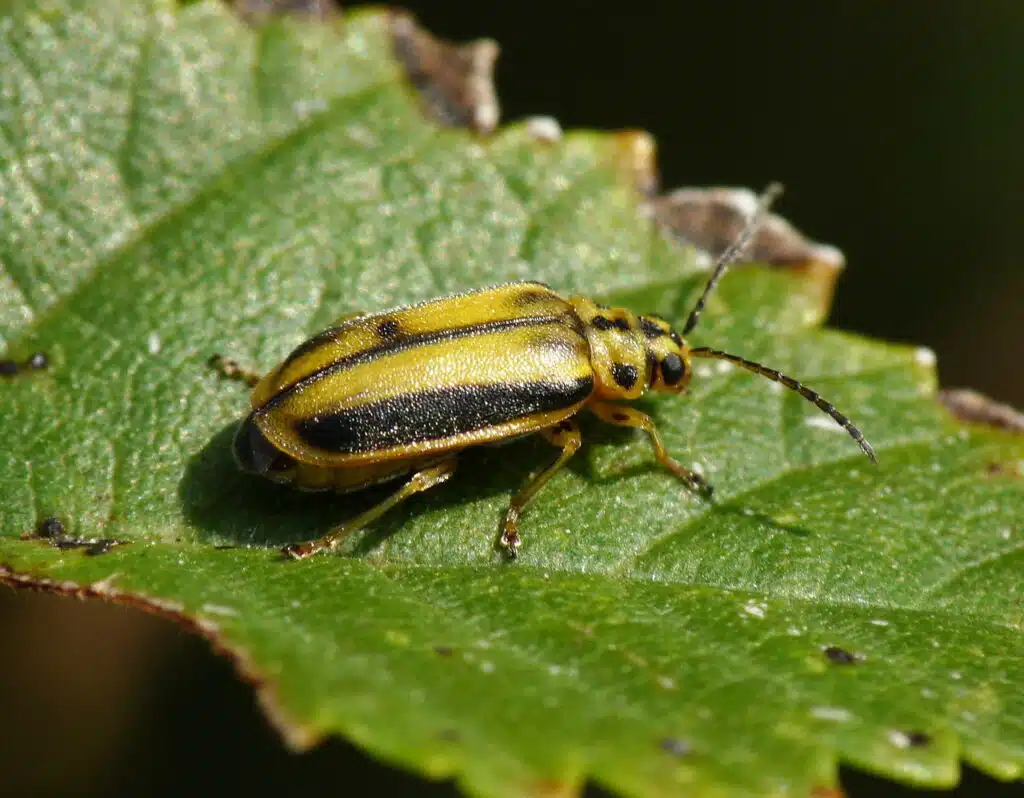
With a yellow pronotum and a green and black elytra, Elm Leaf beetles (Xanthogaleruca luteola) are some of the most important pests of elm trees.
The infestation level of elms is considerable.
Elm Leaf Beetles can signal their presence through a few initial holes in the leaves of elm.
These initial signs eventually lead to skeletonization. This is a process in which only the veins of the leaves remain as the rest of the leaf is consumed.
This species thrives in North America where it has almost no natural predators.
Elm Leaf beetles are also present elsewhere in the world such as in Europe and Australia.
The damage this species makes is limited in Europe as it’s predated by wasps.
12. Zebra Longhorn Beetle
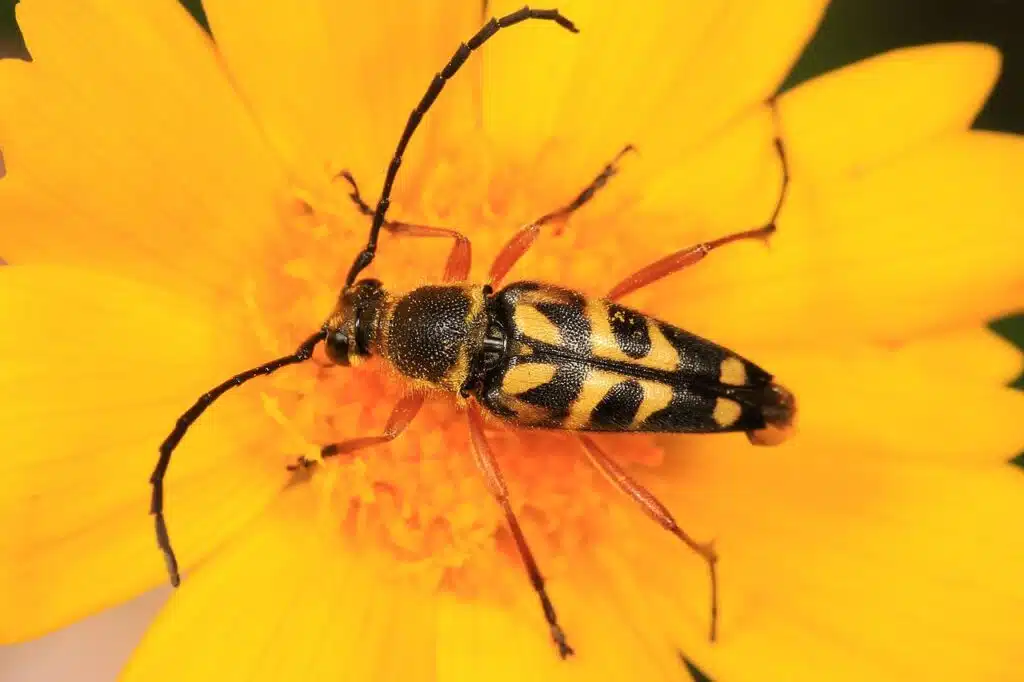
The Zebra Longhorn Beetle (Typocerus zebra) is a species that grows to 16mm.
Beetles of this genus have black and yellow coloring. The elytra are mostly black.
Yellow parts of the elytra are seen in the form of triangles, bands, and stripes.
The Zebra Longhorn Beetle has very long black antennae. Its antennae can be as long as ½ of its body size.
The legs of the species are either red or brown.
The alternating black and yellow elytra coloring of the species inspires its name. Some suggest these contrasting black and yellow colors of the elytra are the direct results of mimicry efforts of the species that tries to resemble wasps.
13. Squash Lady Beetle
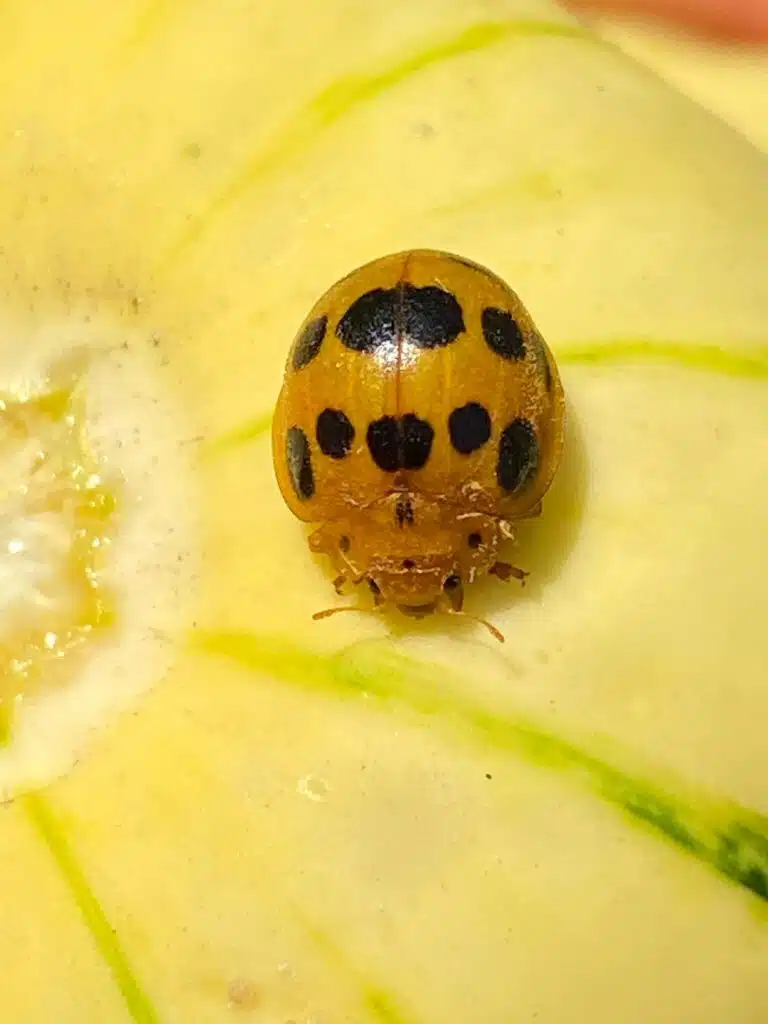
The Squash Lady beetle (Epilachna borealis) is one of the common species of black and yellow bugs that are seen as pests.
Beetles of this specie look similar to ladybeetles.
Black and yellow coloring are specific to the elytra of this species. Yellow is the main color while black coloring is present in the form of small spots.
The Squash Lady beetle species is common on plants that resemble cucumbers. In the US, the Squash Lady beetle is a known pest of squash.
You can remove the beetle by hand whenever it starts chewing on the squash leaves you have at home.
Alternatively, you may also consider pesticides when growing squash commercially.
14. Yellow-horned Flower Longhorn Beetle
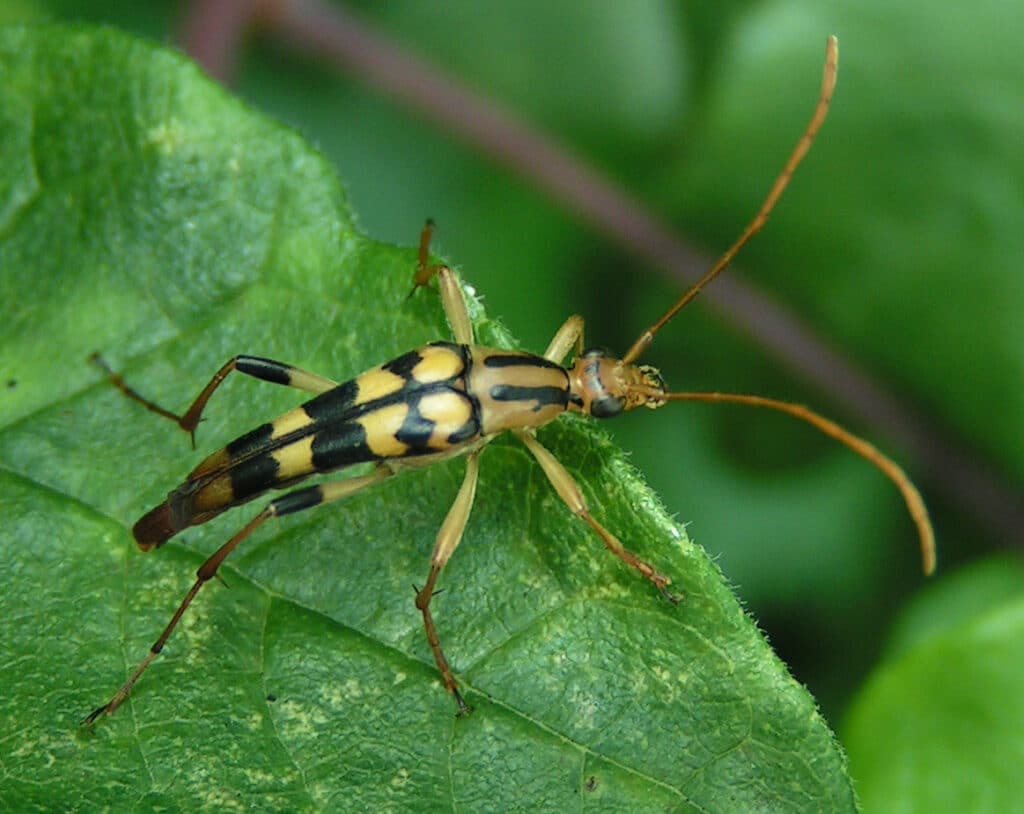
The Yellow-horned Flower Longhorn beetle (Strangalia luteicornis) is a type of black and dark yellow beetle.
Native to the US, the Yellow-horned Flower Longhorn Beetle is a minor pollinator.
Males and females of the species are seen on Swamp root flowers. They consume the nectar of these flowers and they also live and mate on the flowers.
It’s the white flower of the Swamp root that attracts the Yellow-horned Flower Longhorn beetle.
This is one of the few beetles in the black and yellow range that doesn’t adapt its color to the color of its host plant.
15. Bean Leaf Beetle

The Bean Leaf beetle (Cerotoma trifurcata) is mostly yellow. It has a few black spots on the elytra and a yellow-black head.
Bean Leaf Beetles might also appear orange in some parts of the country.
These beetles have known pests of various plants and vegetables. Most notably, the Bean Leaf beetle is known for being a pest of beans.
It eats the leaves of various bean species and it also lay eggs directly in bean and soybean seeds.
Manually controlling this species is considered difficult. Pesticides are widely used against the Bean Leaf beetle.
16. Alligatorweed Flea Beetle
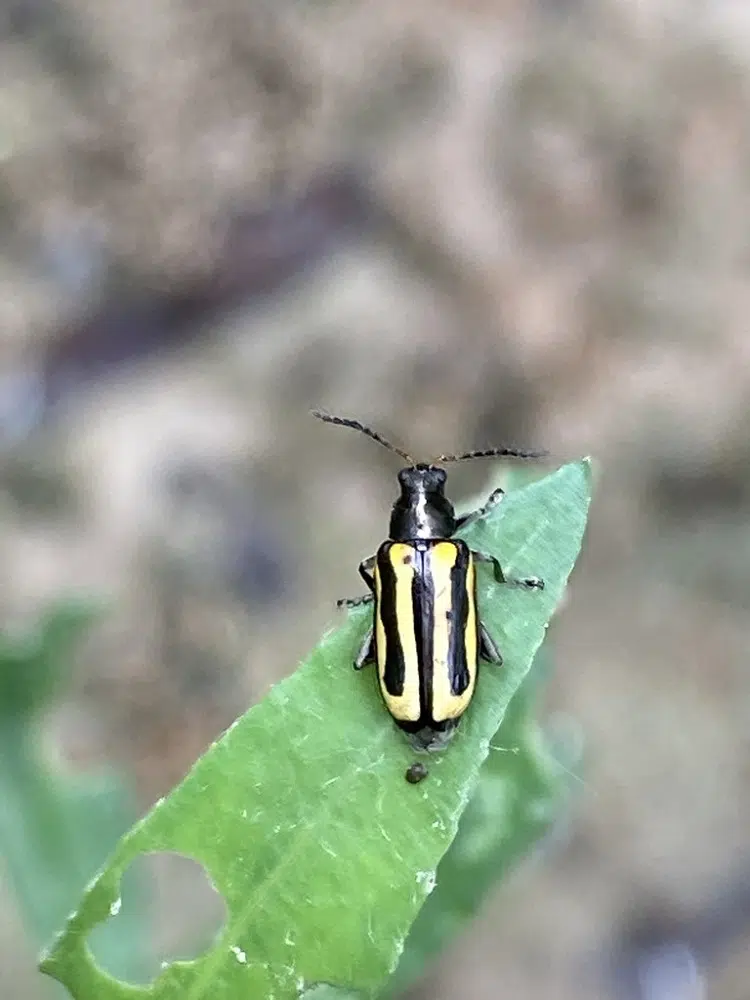
Alligatorweed Flea beetles (Agasicles hygrophila) are among the few beneficial species of black and yellow beetles.
As their name suggests, these beetles help control the noxious Alligatorweed. This is a species of aquatic plants the beetle consumes, starting with the leaves.
Alligatorweed Flea beetles have a common striped body look. Alternating vertical black and yellow stripes describe the species.
The larvae of this species are commonly seen on the leaves of various plants in the Southeastern US.
After pupation, most Alligatorweed Flea beetles turn yellow-black with a smaller percentage turning green-black.
Adults of the species remain relatively small compared to other beetles. They grow to a maximum size of 7mm.
17. Harlequin Flower Beetle
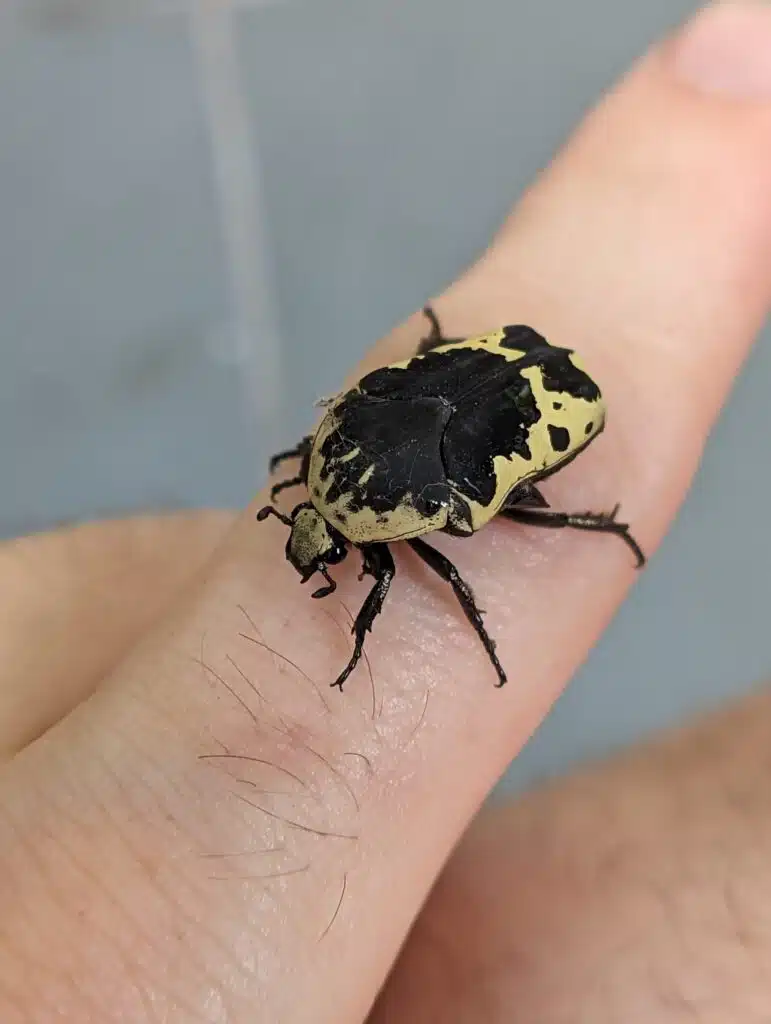
Growing to a size of up to 21mm, the Harlequin Flower beetle (Gymnetis thula) is one of the most complex species of beetles in the US.
It leaves in a few territories across the Eastern United States.
This beetle is known for being black-dominant in the case of males and yellow-dominant in the case of females.
Harlequin Flower beetles are known to feed on plant sap.
These beetles have also adapted to drinking leaking sap that comes from tree trunks.
This is why the Harlequin Flower beetle can spend the entire day sitting and eating the sap that leaks from trees.
Beetles of this genus have been seen on various oak trees. Harlequin Flower beetles are also known for being attracted to False willows.
18. Round-necked Longhorn Beetle

The Round-necked Longhorn beetle (Clytus ruricola) has a black body with red legs.
Its elytra show a few yellow marks in the form of lines and dots.
Similar to many black and yellow beetles, the Round-necked Longhorn beetle has very long antennae.
The antennae of the beetles help them find their way around and sense changes in solid texture through vibrations.
Part of the Longhorn beetle family, this species is sometimes confused with typical beetles with an extra pair of legs.
The antennae of this species are sometimes even longer than the body.
19. Painted Hickory Borer
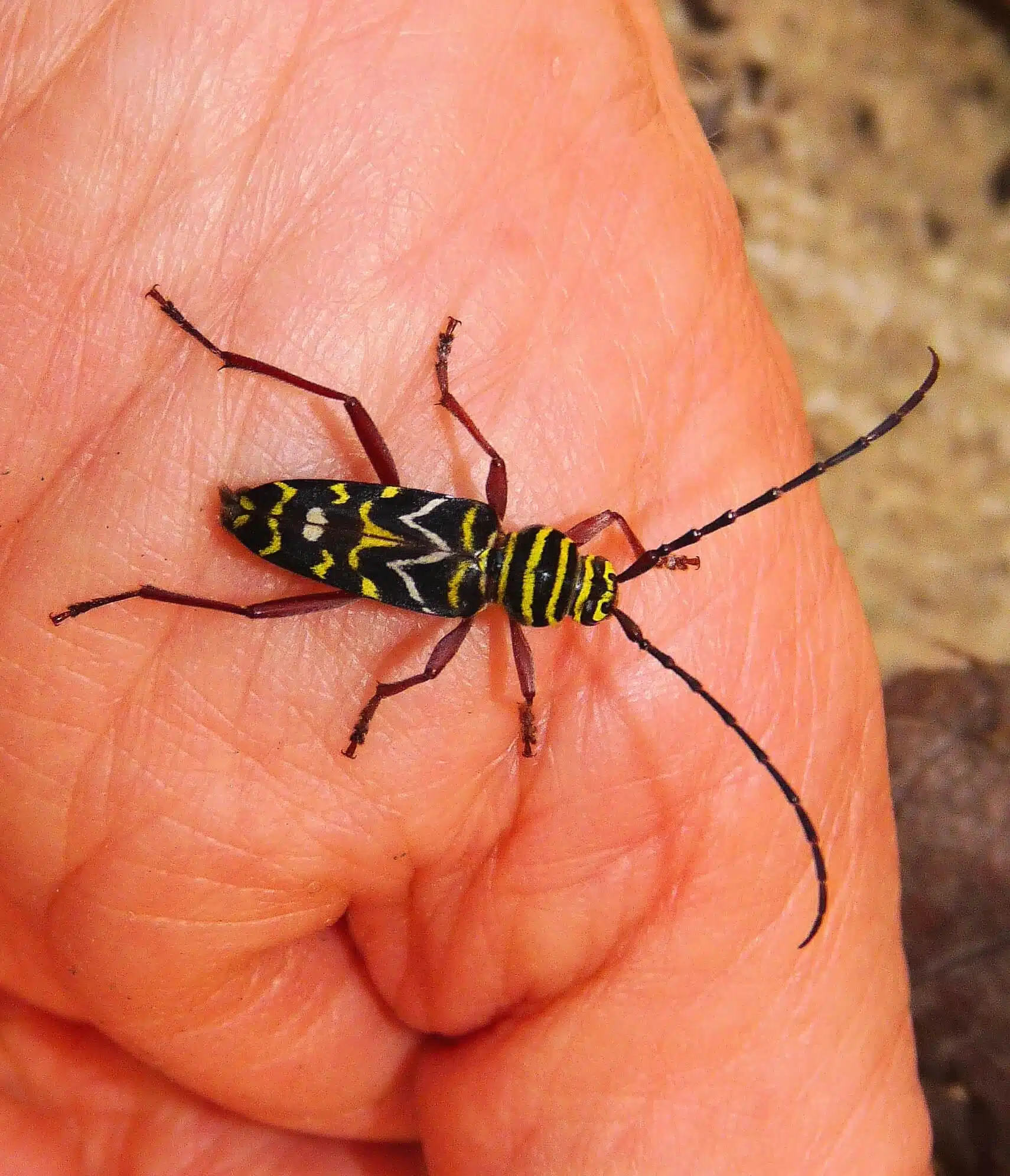
The Painted Hickory borer (Megacyllene caryae) is a black and yellow borer species common in Texas.
Beetles of this genus are known for their vivid coloring which inspires their name.
A black body is dominant in this species. Stripes are seen from head to elytra on the beetle.
Painted Hickory Borer are good indicators of a newly-dead hickory tree. The larvae of the beetles only eat dead hickory.
Unlike other beetles that specialized in a sole species of trees, the Painted Hickory borer eats a wider range of dead hardwood.
Beetles of the genus grow to a maximum size between 10 and 20mm and they first emerge in March.
20. Judolia cordifera

Beetles of this genus are only seen in black and yellow colors. The range of the beetles is diminishing and is currently limited to scattered locations across Eastern North America.
Both the larvae and adults of the species feed on plants and vegetation without showing parasitic behavior.
The larvae of the Judolia cordifera eat chestnuts. Adults feed on various flowers and they drink nectar throughout the day.
One of the reasons this species isn’t yet seen as a major threat is the somewhat limited range across Eastern states.
Judolia cordifera has the potential of becoming a serious threat in the future, particularly through the threatened nature of the native American Chestnut.
21. Texas Soldier Beetle

The Texas Soldier beetle (Chauliognathus scutellaris) is one of the yellow-dominant black and yellow beetles native to North America.
This species has long yellow elytra. 4 black spots are visible on the elytra of the beetle.
Vivid yellow coloring makes the beetles one of the species predators stay away from.
The legs and antennae of this species are long, thin, and black.
Texas Soldier beetles are native to Texas with limited to the inexistent presence in other Southern states.
Beetles of this genus feed on flower nectar.
22. Mesquite Borer
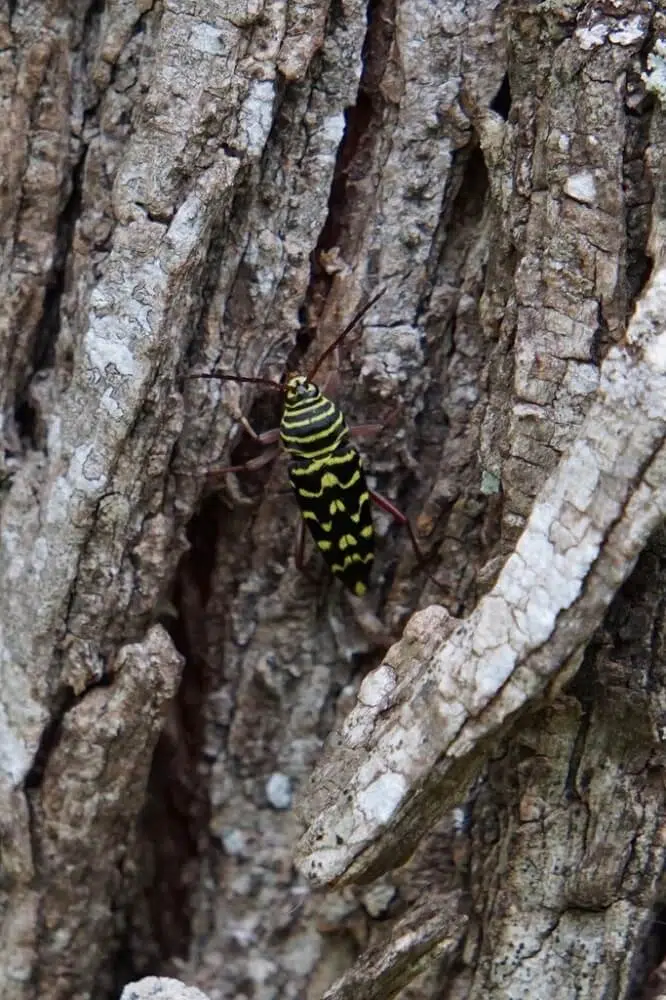
Mesquite borers (Placosternus difficilis) are some of the most common beetles seen on Mesquite trees. This is a type of tree with a high presence in Southern US territories, especially in Texas.
The tree is rarely seen in Arizona and New Mexico.
Mesquite borers lay eggs directly in these trees and they begin eating the trees as they turn to larvae.
The impact on Mesquite trees by this species is limited. These beetles move on to feed on nectar once they pupate.
Mesquite trees these beetles are seen as having a historic role in the history of the United States. Mesquite lumber was used to build ships.
23. Typocerus octonotatus
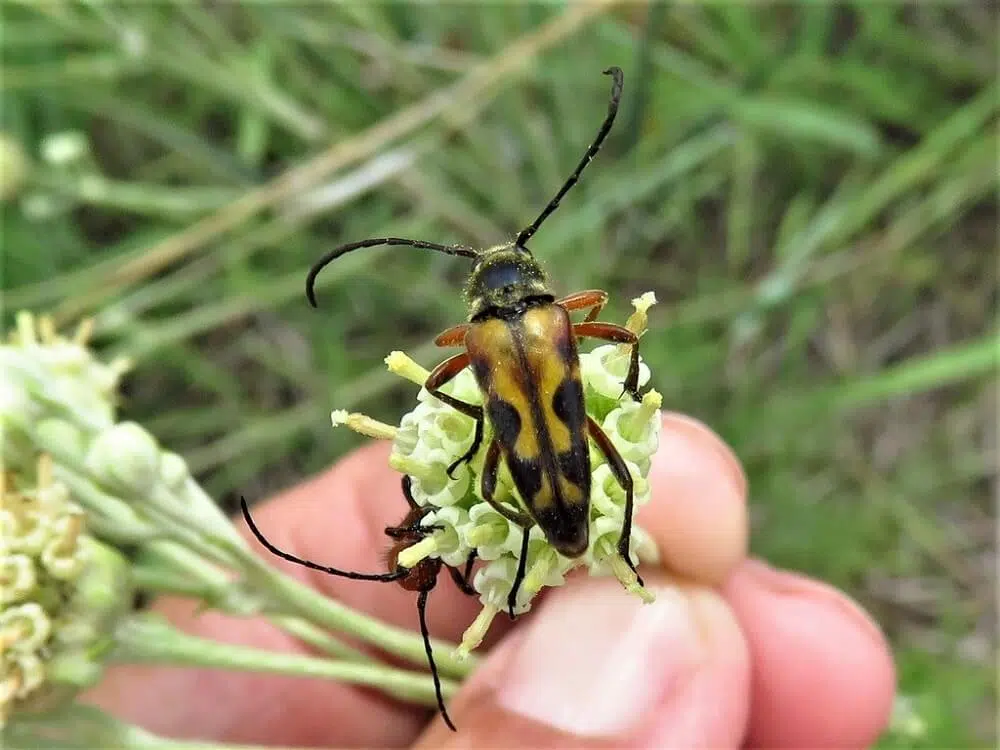
These beetles have a yellow-orange color with black marks.
Beetles of this genus feed on pollen and nectar. They take on the color of their favorite flowers, which are yellow and orange.
Yellow-dominating body coloring with black spots works to their advantage as they improve natural camouflage while eating flower buds.
These beetles might only be distinguished from other black and yellow beetles through the length of their antennae. Part of the Longorhn genus, these beetles have very long antennae.
24. Trypherus frisoni

This species of beetle grows to a size of at least ¼ inches. Its body is mostly black and it resembles black wasps.
Yellow coloring is minimal and even difficult to see on young beetles of this family.
Only 2 yellow stripes are visible on the body of the beetle.
Its antennae are also black, similar to the body. The legs of the beetles are red-brown.
Trypherus frisoni is one of the black and yellow beetles found in the Northern states.
While many other black and yellow beetles are common in Texas, Arizona, and California, this species is seen as far north as Ohio.
25. Notched-tipped Flower Longhorn Beetle
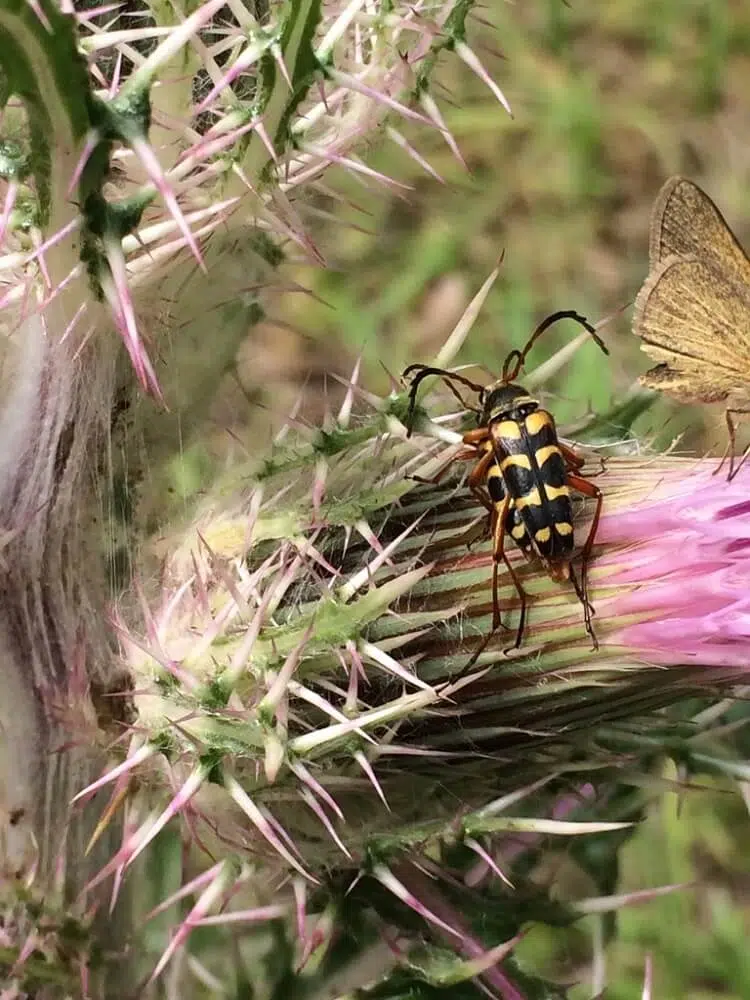
This yellow and black Longhorn beetle (Typocerus sinuatus) is known to mimic bees.
It feeds on nectar and pollen and many think of it as a type of bee at first.
Notched-tipped Flower Longhorn beetles have long antennae as all members of the Longhorn group.
These beetles prefer to feed on nectar but they also feed on pollen.
6 black spots on the elytra make for easier species identification.
Notched-tipped Flower Longhorn beetles are sometimes seen in gardens and parks feeding on various flowers.
These beetles have a long flight season sometimes being seen in gardens up to early fall.
26. Sunburst Diving Beetle

Sunburst Diving beetles (Thermonectus marmoratus) are among the few aquatic species of black and yellow beetles.
These bugs resemble Water bugs in their oval flattened shape.
Black body color is completed by yellow and white dots as well as bright yellow lateral stripes.
Accustomed to living both on water and dry land, this type of beetle is also one of the species that eat all types of water insects.
The beetle also eats insects that lay eggs in the water such as mosquitoes. Sunburst Diving beetles can feed both on dead and newly dead mosquitoes.
Beetles of this genus are known for having the ability to swim. They also have very good vision.
As a result, they can make a move on certain insects quickly as they spot them from a greater distance.
This species is only native to California and Baja California and no other territory across the US.
Females are only seen when they lay eggs. Most eggs are laid directly in water.
The emerging Sunburst Diving beetle larvae feed on insect eggs as well as on a range of water insects and water animals.
27. Iron Cross Blister Beetle
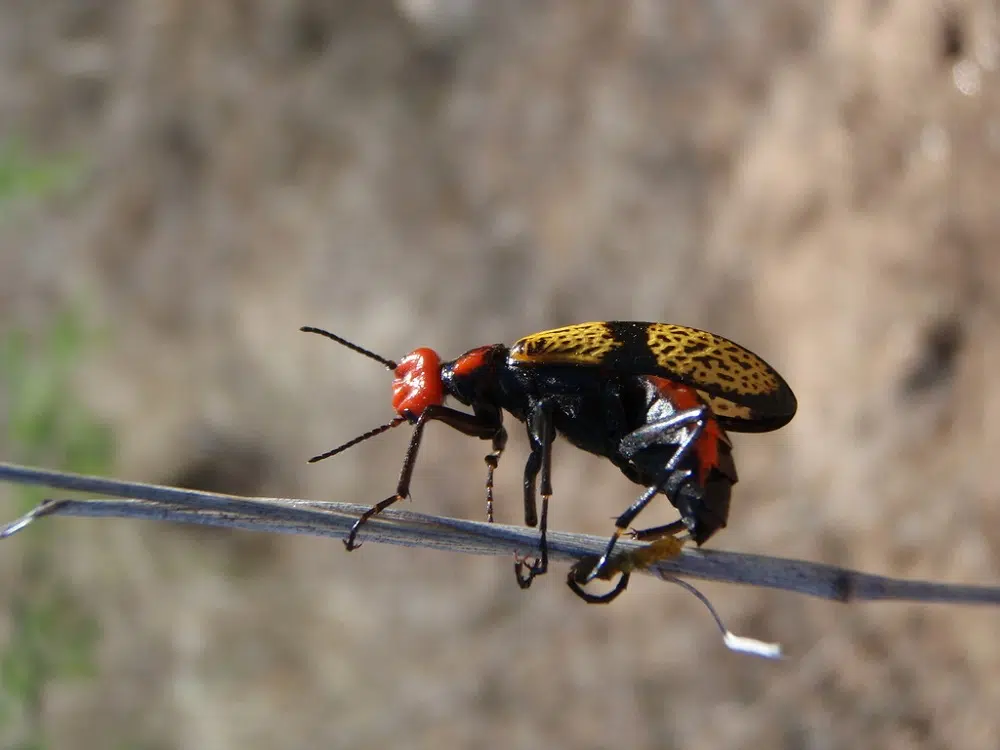
The Iron Cross Blister beetle (Tegrodera aloga) has a black body with yellow mesh-like striations across the elytra.
Beetles of this genus live in some of the most difficult conditions as they prefer arid and desert habitats.
The Iron Cross Blister beetle is one of the medically significant black and yellow beetles.
Its legs build a toxin that’s deadly to some types of livestock. Ingested in large quantities, this toxin can also be lethal to humans.
Even touching this black and yellow beetle can result in plenty of skin blisters.
Cantharidin is the toxic compound in the beetle which causes blisters, as its name implies.
The same cantharidin toxic compound also has beneficial uses, especially for humans.
This toxic element is used in tattoo removal procedures. Researchers are now trying to establish if this chemical of Iron Cross Blister beetles can also have some benefits in patients with various types of cancers.
28. Cryptocephalus leucomelas
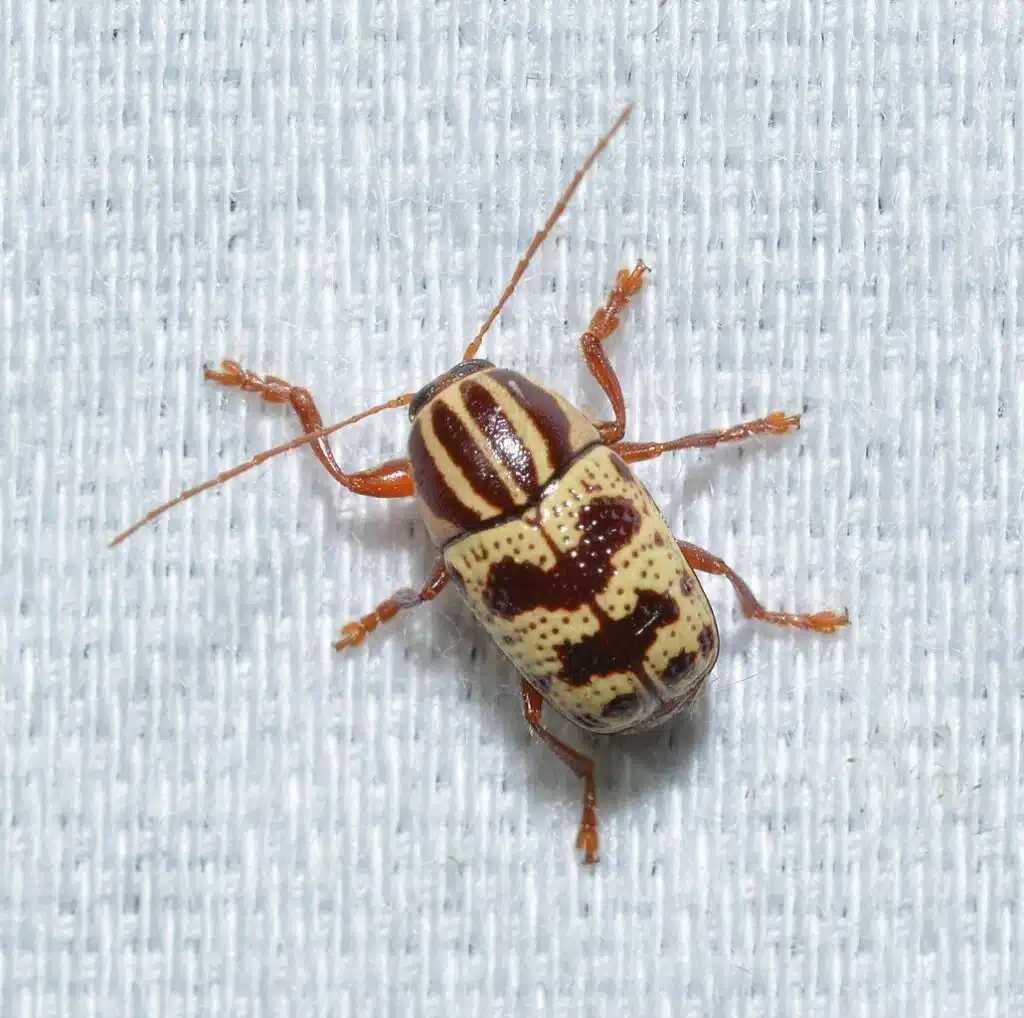
This common type of black and yellow beetle is encountered in the Northern states.
You can identify it by its yellow and brown-black patterns. The elytra are mostly yellow with 2 brown-black bands and 4 smaller spots.
The rest of the body has yellow and brown or black stripes with brown legs and brown antennae.
This species is mostly herbivorous in adulthood.
It feeds on a wide range of plant tissue including plant leaves. You can distinguish it among other types of bugs that eat plant leaves by its very long antennae.
29. Eudiagogus rosenschoeldi
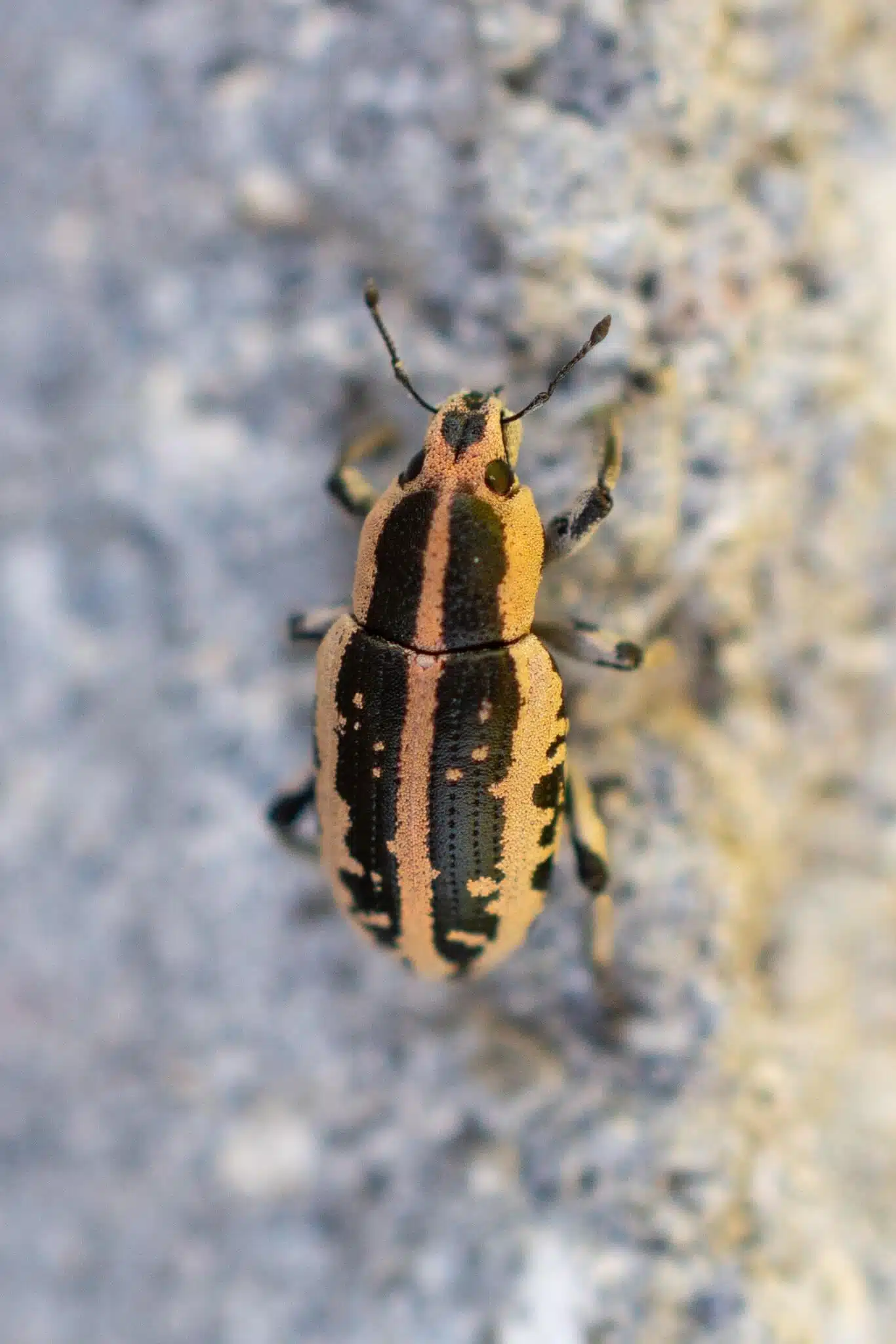
This species is a type of beetle with an elongated snout.
It feeds exclusively on pea family plants and roots. The beetle does not feed on any other plant outside the Fabaceae family.
You can identify the species by its bark-like coloring patterns. It comes in a gray and dark gray color, in orange and black color, or black and yellow color.
These bugs are true weevils and this means they have a robust wide body, a smaller head, and an elongated snout.
The weevils have short thick legs and they can bore deep in the ground for the roots of various peas.
30. Wild Olive Tortoise Beetle
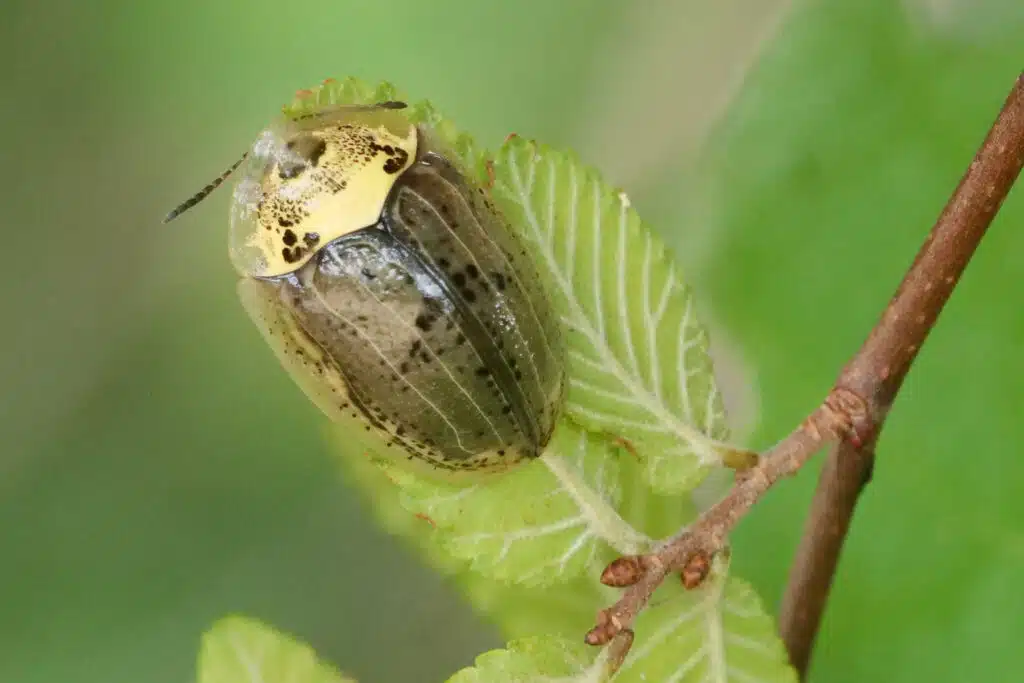
Wild Olive Tortoise beetles (Physonota alutacea) get their name from their flattened body shape that resembles the oval shape of turtles.
These beetles have a mix of yellow, black, and olive coloring as adults and vivid black and yellow striped body coloring as larvae.
It has a wide presence in Southern Texas and further into Mexico and Central America.
Wild Olive Tortoise Beetles don’t feed on olives but Anacahuita flowers.
These are shrubbery flowers found in very warm climates of Southern US states and further South into Mexico.
31. Lewis’ Soldier Beetle
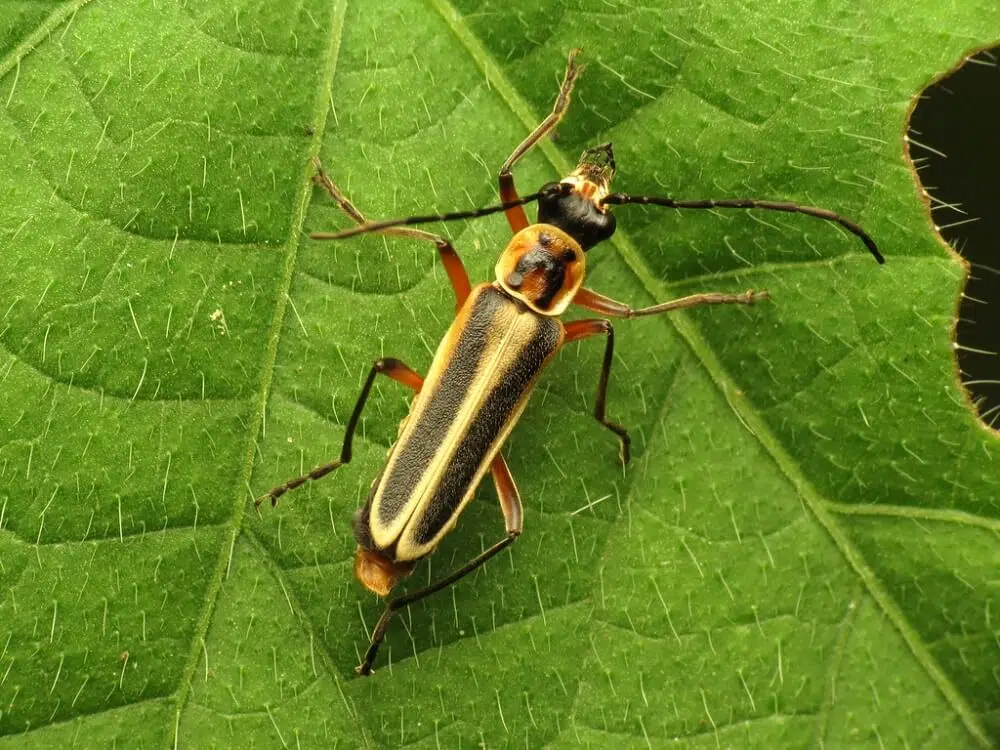
Lewi’s Soldier beetles (Chauliognathus lewisi) only have black and yellow coloring. These beetles have an elongated body with black wings that have yellow borders.
The head of the species is also yellow and black.
Lewi’s Solider beetles eat insects as larvae as they’re quite active. They then turn towards pollen and nectar from many yellow flowers as adults.
The yellow and black coloring helps them blend in with the yellow flower buds they feed on.
32. Redbud Borer
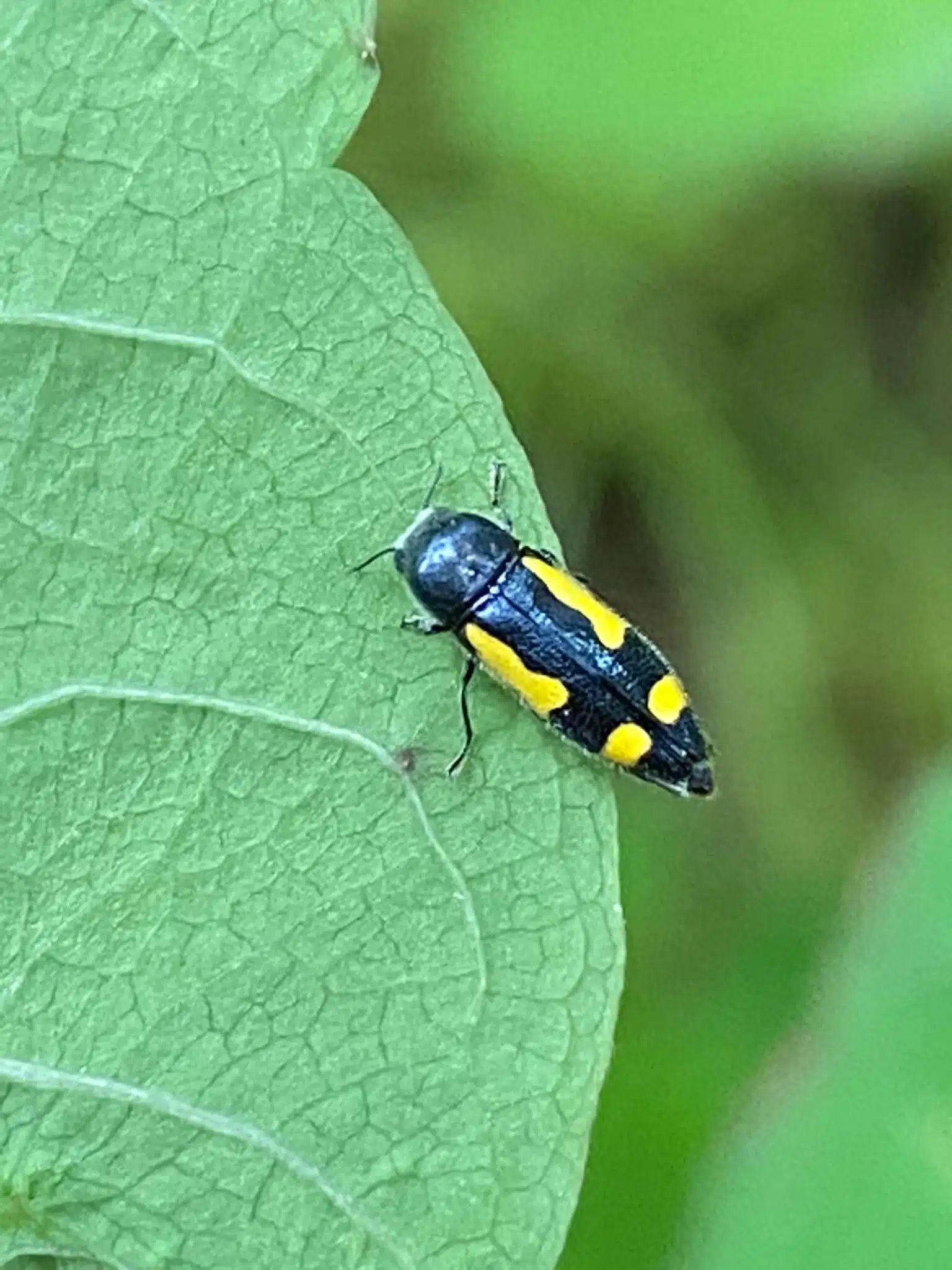
This metallic woodboring species (Ptosima gibbicollis) has black and yellow glossy coloring.
Most of its body has a black color with just 4 yellow spots.
Members of the species have an ovoid shape and a dark black head without any bright or yellow marks.
The species is a woodborer and it prefers wood that has just died to nest in.
33. Rabbitbrush Beetle

Common in Western US territories, Rabbitbrush beetles (Trirhabda nitidicollis) have black and yellow coloring.
Pale yellow and black stripes are visible on its elytra. The head has a darker yellow coloring.
The species can be beneficial in areas where asters such as rabbitbrush prevent proper plant growth, such as on crops.
Bugs of this genus are often seen as beneficial as they help control such weeds in key areas among other plants.
Since Rabbitbrush beetle can also eat other plants it’s best to control their populations. Some species of ladybugs are predators of Rabbitbrush beetles helping control their numbers.
34. Strophiona tigrina

Beetles of this genus have vivid contrasting yellow and black coloring.
The base color is black while the yellow pattern on the elytra is irregular.
Some data suggests these beetles mimic the colors of wasps since they feed on pollen and nectar. They can be among the species that are taken as wasps but they cannot fly.
Strophiona tigrina is a species of beetle that feeds on the pollen and nectar of various wildflowers, particularly white flowers.
Natural predators of the species include parasitoid wasps
35. Acmaeodera amplicollis
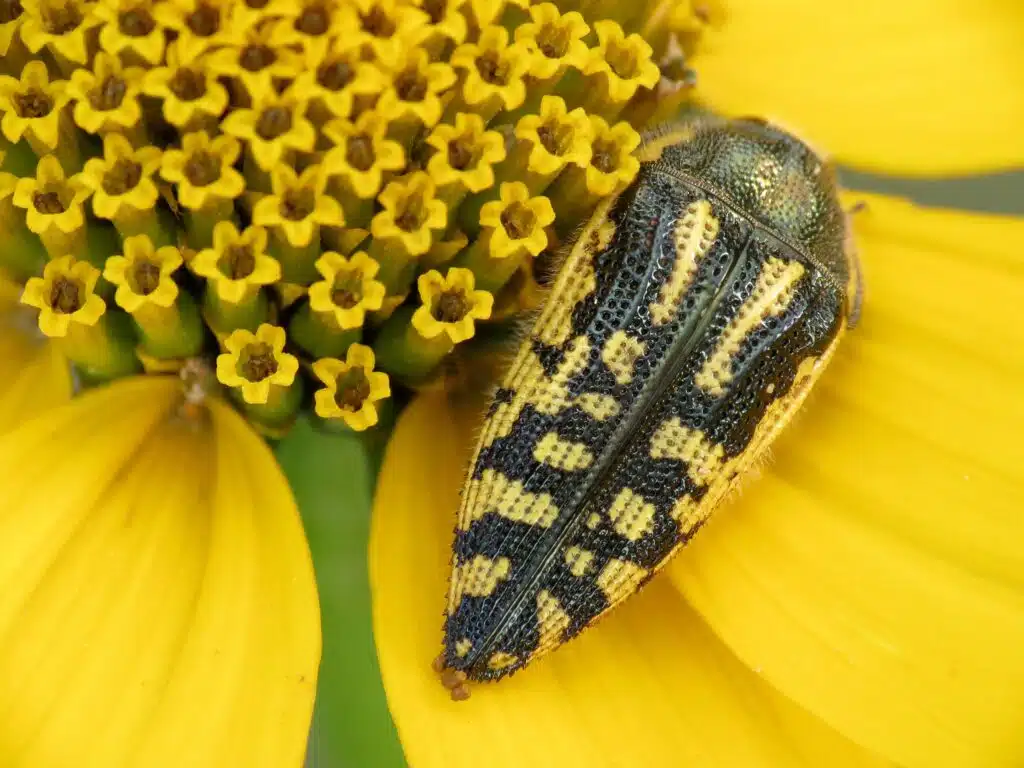
This species of beetle has black and yellow coloring to blend in with the plants it feeds on.
Some of the yellow plants the species is seen on in North America include Desert marigolds and Crownbeard.
This species has a black body that is wider towards the head.
Irregular orange marks and stripes are visible on its elytra.
Small perforations are characteristic of the wings of the Acmaeodera amplicollis. These hole-like grooves allow the species to blend in with yellow flower buds better.
36. Banded Ash Borer
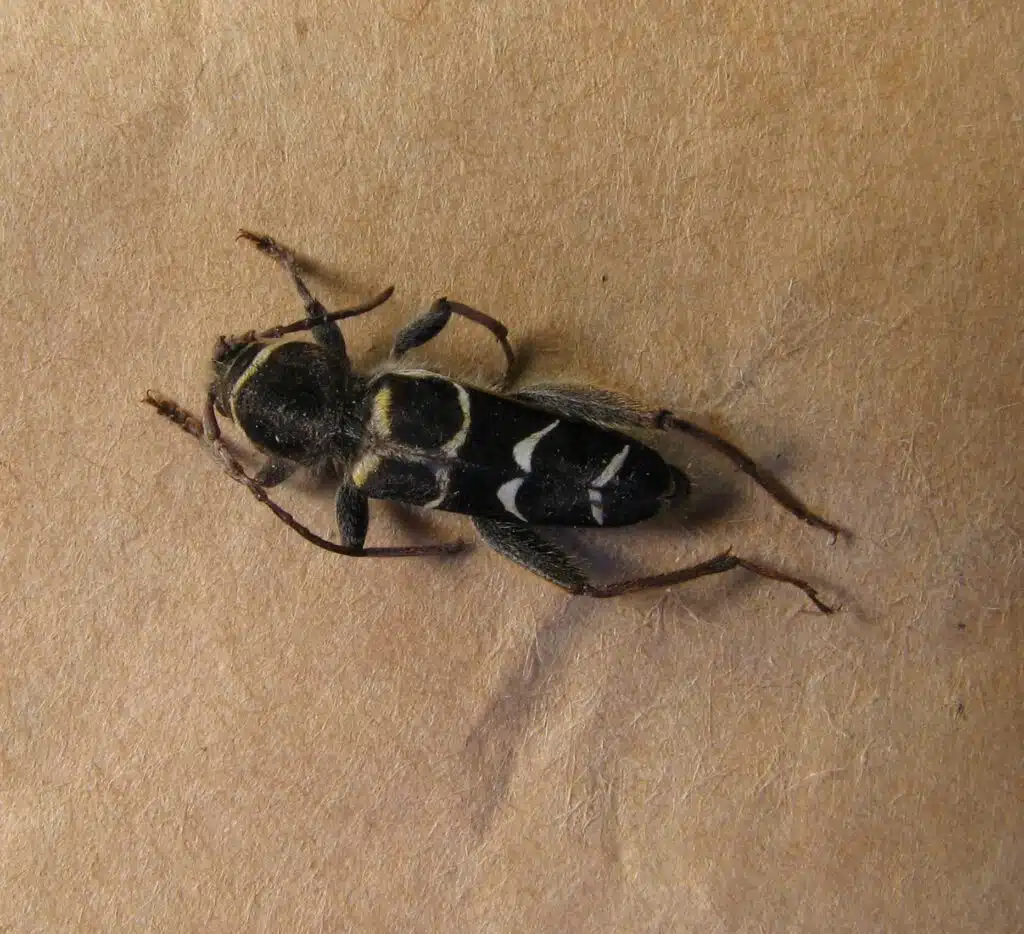
Banded Ash borers (Neoclytus caprea) are types of black and yellow beetles that bore into the sap of ash trees. This species prefers dead ash trees.
Some of the largest populations of Banded Ash borers are seen in ash logs stored for winter.
This species isn’t solely focused on ash wood as it also bores in elm and even in white oak.
The species lay eggs in dead ash tree bark so it doesn’t kill living ash.
You can identify the species by its uniform black body and black head. Yellow stripes are seen across its elytra. The underbelly of the species has wasp-like alternating black and yellow stripes.
37. Western Corn Rootworm Beetle
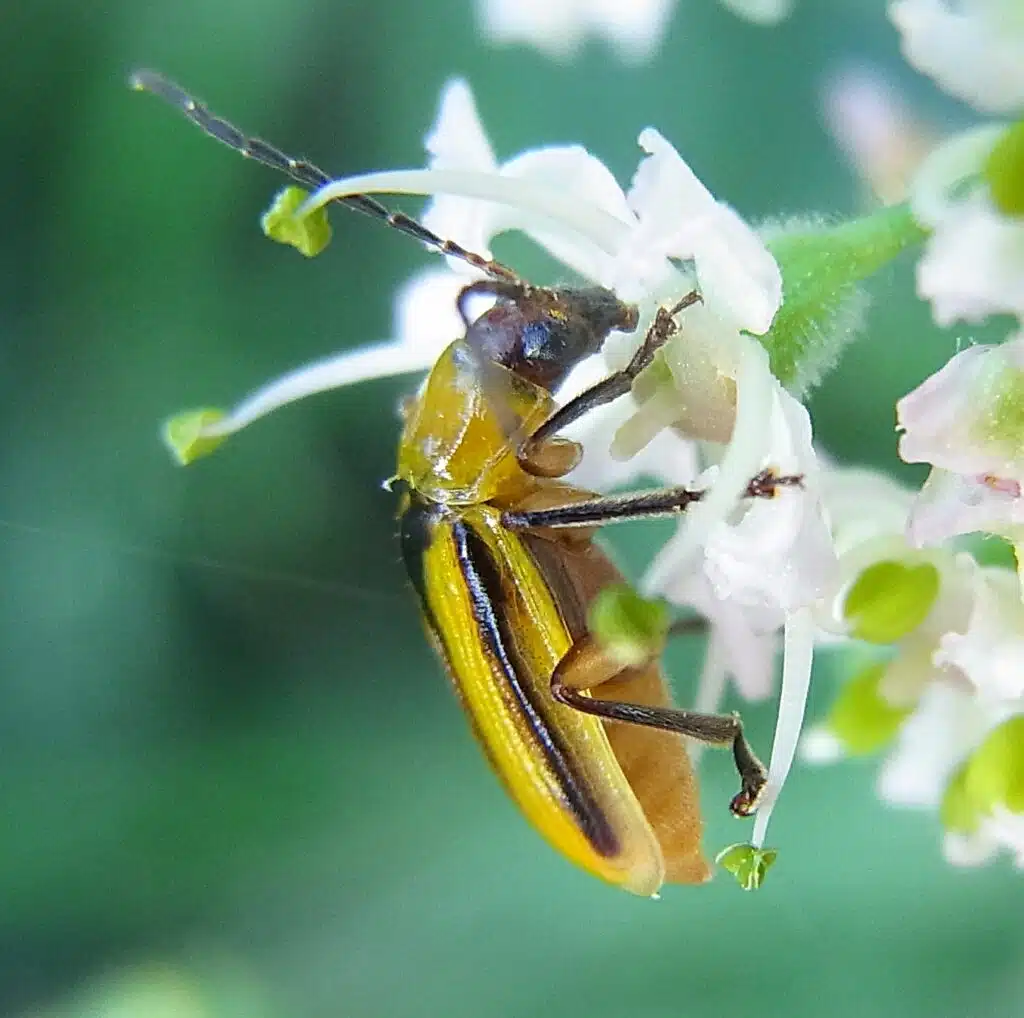
Western Corn Rootworm beetles (Diabrotica virgifera) resemble their Northern counterparts in habits.
These beetles affect large percentages of corn production in the Western states.
Almost all untreated corn is subject to the damages created by this species that feeds on corn.
Adult Western Corn Rootworms feed on corn leaves and exposed kernels. The damage made by adults is considered minimal.
However, the larvae of the Western Corn Rootworm beetles are responsible for almost all of the damage to corn crops.
The larvae feed on the fine roots of corn in the ground essentially halting its growth and even killing corn.
The use of insecticides is common against these corn-eating beetles.
Some farmers rotate crops as the eggs of these black and yellow beetles overwinter in the ground waiting for spring to arrive to hatch into larvae that feed on the roots of young corn.
38. Spruce Zebra Beetle
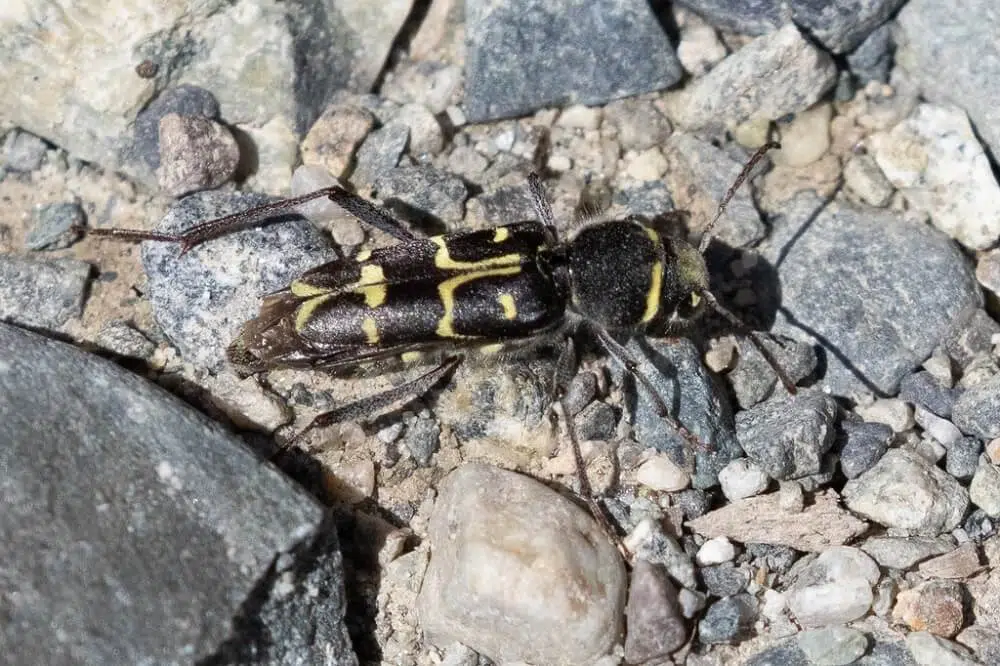
The Spruce Zebra beetle (Xylotrechus undulatus) is one of the species with numerous presence in North American woodlands.
Spruce Zebra beetles don’t need much direct sunlight as other black and yellow beetles.
As a result, they live on spruce and conifers in forests at high altitudes.
Beetles of this genus feed on the tree itself. They also lay eggs in the bark of coniferous trees.
You can identify this species by its black body with yellow strips behind the head and yellow stripes across the elytra.
39. Arizona Net-winged Beetle
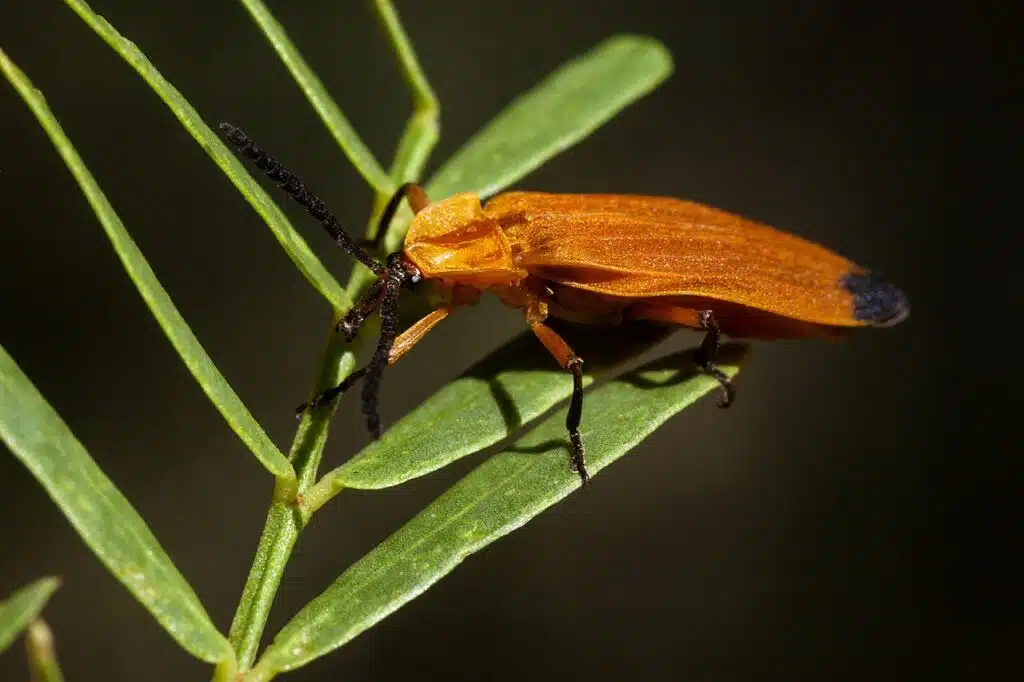
The Arizona Net-winged beetle (Lycus arizonensis) is one of the species of net-winged beetles in the US.
Beetles of this genus have a triangular body with large yellow-orange wings and a black head.
Arizona Net-winged beetles have vivid coloring which resembles some of the flowers a part of the adult members of the species visit.
Some Arizona Net-winged beetles feed on nectar while most adults don’t feed at all as they live short lives.
Native to Southwestern territories, the species is known for its preference for open areas with plenty of flowers.
40. Festive Diabrotica
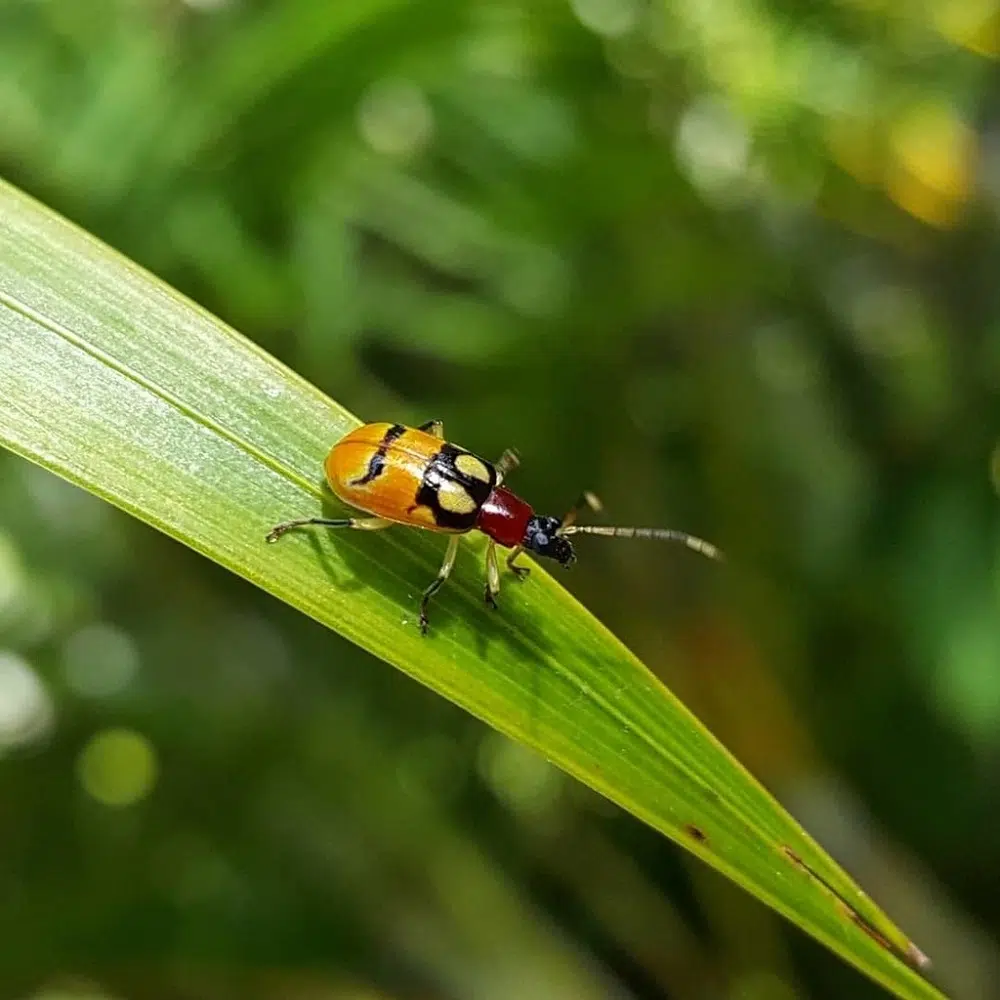
The Festive Diabrotica beetle (Diabrotica adelpha) is common in Texas. Beetles of this genus grow to a maximum size of 7.4mm.
Yellow is the dominant color of the species with black marks and lines across the elytra. The head has a red color.
First appearing in May, this is a species only found in Texas and Southwards in Mexico.
41. Acmaeodera Alicia

This species has black and yellow coloring and it’s found in Southwestern US states.
It feeds on a wide range of small green leave such as those of the asters family.
The shape of the beetles is ovoid. They have a black body with a few yellow marks and stripes.
Larvae feed on a wide range of acacia flowers, leaves, fruits, and roots.
Some Acmaeodera Alicia beetles are known for eating the pollen or nectar of cacti.
The natural habitat of the species expands from California to Arizona.
42. Acmaeodera solitaria
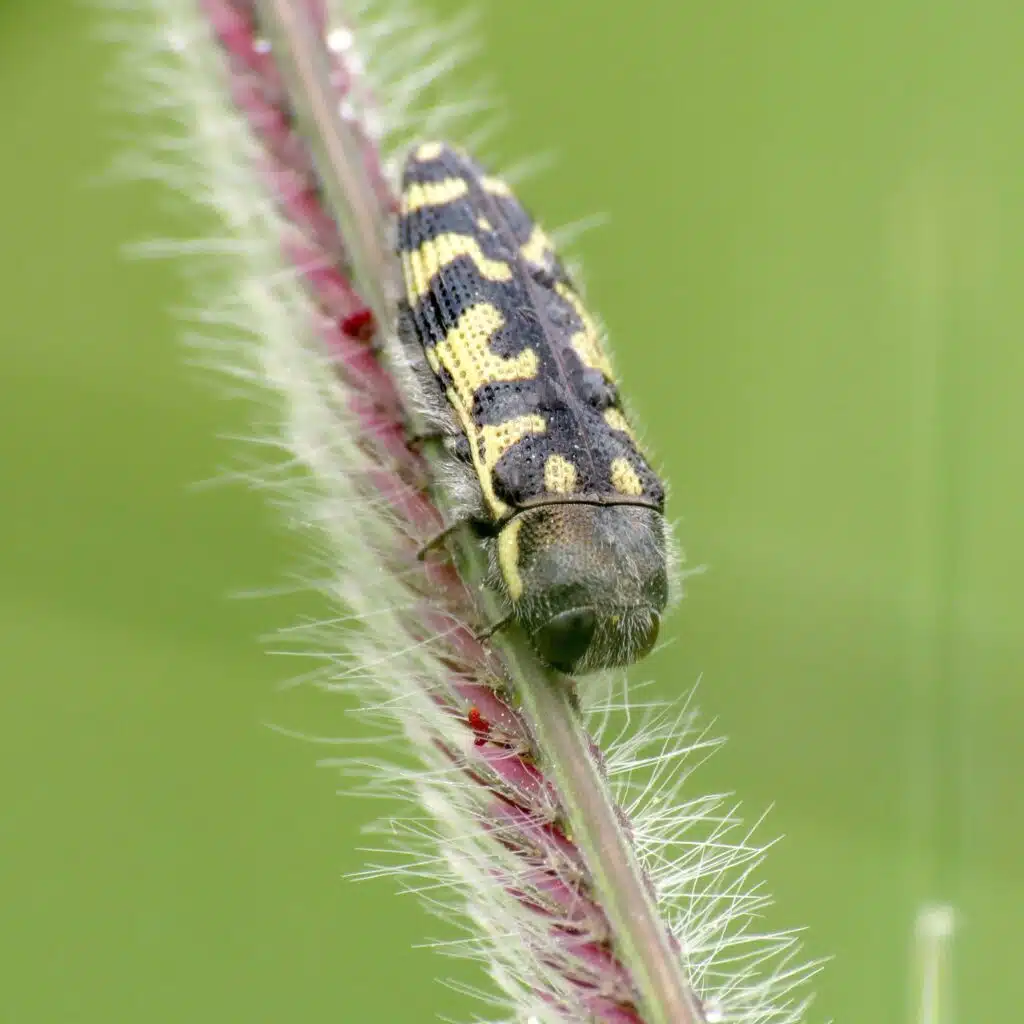
Beetles of this species are found in Southwestern US states. It’s identified by its contrasting black body with yellow stripes.
The elongated body of the species is black. It has yellow interrupted stripes on the elytra.
More common in Central America than in North America, this species of beetle lays eggs in newly-dead hardwood.
43. Typocerus lunulatus

Black and yellow beetles of this genus grow to a size between 8 and 12mm.
They have a black body with wide orange bands on the elytra.
An atypical feeding pattern is described for this species, especially with the larvae.
The larvae of this species feed on decaying pine. Its role as a natural recycling species is minor.
Adults change their diet towards pollen and nectar.
Some of the states with high Typocerus lunultus populations include California, Texas, and Florida.
44. Globemallow Leaf Beetle

Globemallow Leaf beetles (Calligrapha serpentina) feed on globemallows in California and Texas.
These beetles are seen in various morphs, all with black coloring or patterns.
A common morph is a black individual with yellow stripes and marks. These bugs also come in a black base color with green, orange, or red marks.
The larvae of the species are either red or red-brown, depending on their growth stage.
One of the distinct traits of the Globemallow Leaf beetle is that all of these morphs come in similar coloring patterns. It’s just the colors that vary.
45. Systena gracilenta

These beetles are native to Southern US territories and Northern Mexico.
Their presence is considerable on Baccharis shrubs. These are plants of the aster family.
You can identify the species by its vertical pale yellow and black stripes covering the elytra. The head of these beetles is orange-brown.
Common along the Devil’s River in Texas, this species is mostly seen from May to August.
46. Amorpha Borer
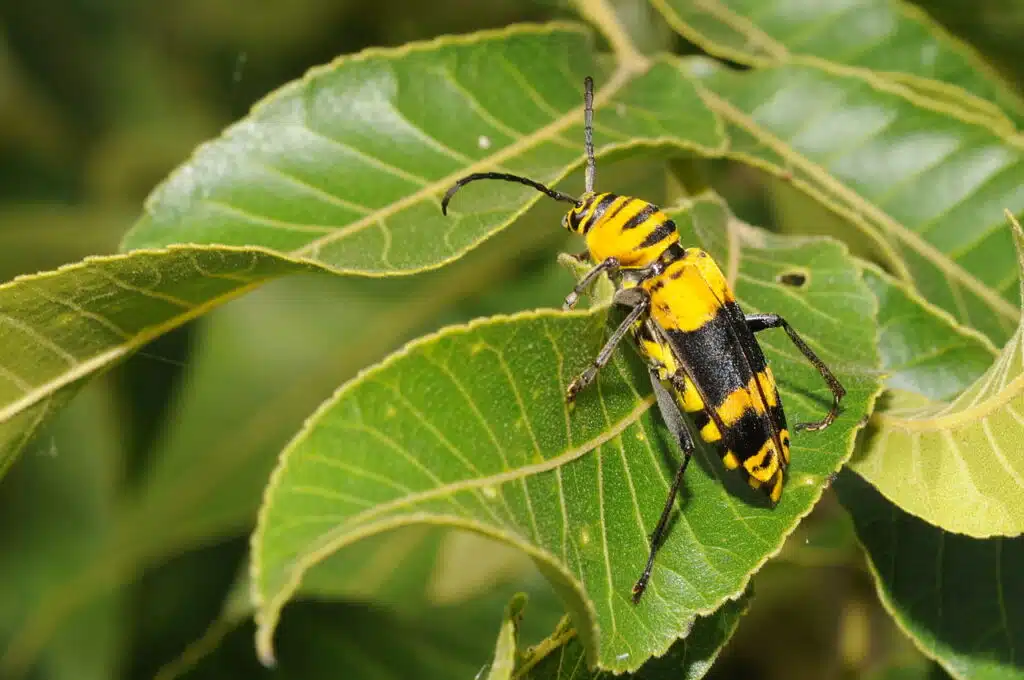
This black and yellow borer (Megacyllene decora) is common in the areas of North America with Indigo-bush plants.
Common from June to October, Amorpha Borers have a striped body.
The main color is black while the stripes are all yellow.
A combination of wide and narrow stripes is specific to these borers.
Today, this species is found on many yellow flowers as well as on white flowers. The Desert False Indigo is one of the most common flowers the Amorpha Borers is seen on.
Amorpha Borers are also common on Goldenrods.
47. Yerba Santa Beetle
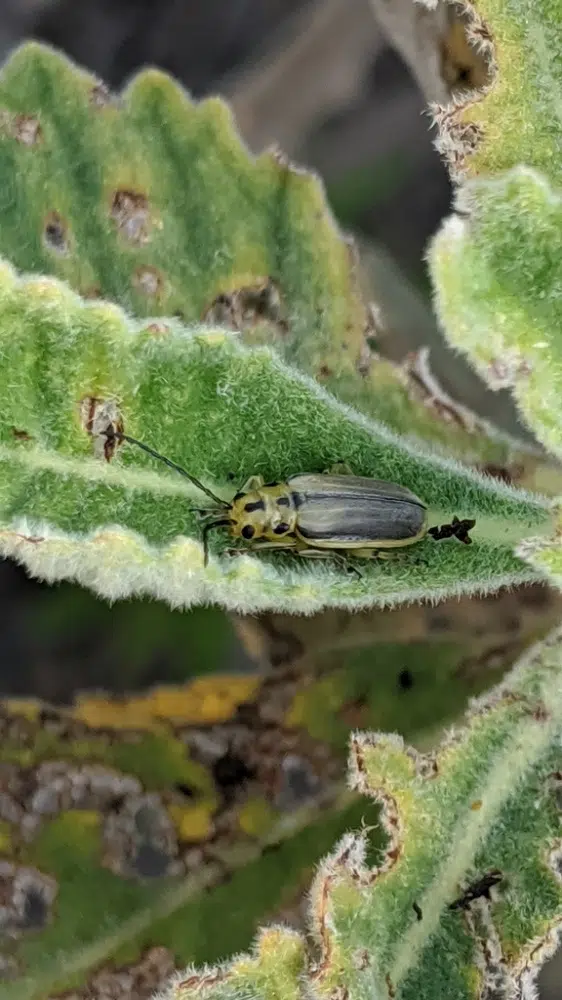
This beetle (Trirhabda eriodictyonis) is a common leaf-eating species. It has black and yellow stripes across its body. The head is yellow and it has 4 black spots.
The yellow color of this species is mostly pale, compared to the vivid yellow coloring of other species.
The herbivorous Yerba Santa beetle larvae look completely different from adults. It has a metallic green color.
As the name of the species implies, these beetles are common on Yerba Santa (Eriodictyon crassifolium).
This plant is common around California and Baja California. It’s known for its wide green leaves the beetle loves.
These leaves can grow to a length of up to 6-7 inches.
Since the Yerba Santa beetle is tied to Yerba Santa leaves and flower buds, it means it can be found on dry slopes where this plant likes to grow.
Further Reading: